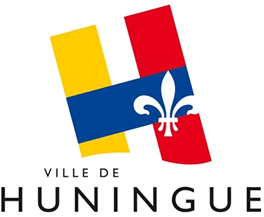De jardin en jardin, les clous nous indiquent l’itinéraire à suivre, avec la place Abbatucci pour point de départ et d’arrivée (durée : 2h30).
Start
You can call me Vauban
My name is Sébastian Le Prestre de Vauban – you can call me Vauban – and I’m here to teach you about the history of Huningue.
More precisely the history of the stronghold which I designed in 1679, commissioned by Louis XIV who wanted an iron ring around our borders.
And of course the city history after 1815, following the orders of Basel to demolish our ramparts which had become too threatening.
And then, and then… can you keep a secret?
You should know that being an army engineer wasn’t my only passion. Can you believe that as a child I wanted to become a gardener?!
You don’t believe me? Follow me for a walk into the heart of Huningue and I will show you my genius regarding botany, blossoming and even ecology.
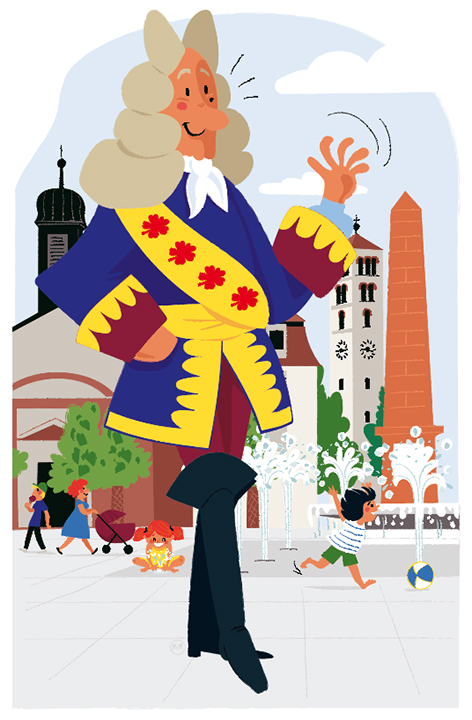
History
In the footsteps of Vauban
Inaugurated on August 26, 1681 the day after only three years of building, the Huningue stronghold was reinforced from 1684 to 1687 with a bridgehead being built on the right bank of the Rhine and hornwork on Cordonniers Island.
A consequence of the Ryswick peace treaty, the latter were destroyed in 1698. The stronghold resisted to three sieges before it was also demolished after the Napoleonic defeats in 1815, in accordance with a clause from the Paris Treaty ordered by Basel. Therefore, “the Huningue fortifications were razed to the ground with no hope of being rebuilt or replaced by any other structures being less than three leagues from Basel.”
Nearly nothing was left from the ramparts built by Vauban as of 1679. The Place Abbatucci, which was once a parade ground, the garrison church or even the Adjutant-General’s office, which is home today to the local history museum are all legacies from a time when the heroes were called Abbatucci, Chancel or Barbanègre.
For shrewd eyes, there are numerous characteristics which show this was the former Huningue stronghold and reveal its long military past, including the trail “And if Vauban had been a gardener”, which retraces all its major steps.
Royal coat of arms
The three fleurs-de-lis and the three golden crowns of the Huningue coat of arms are a reminder that this city was built on the orders of Louis XIV who came here twice, as a royal city and a genuine military barrier for the recently-French Alsace.
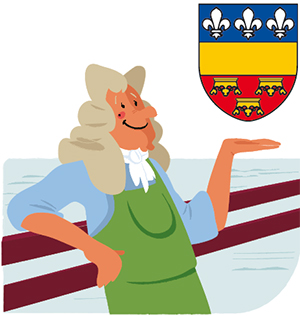
2 / Place Abbatucci
Near my tree
“Lime trees… ATTEEEN-TION!” This is the Marshal speaking. The man who believes that parade grounds are designed to welcome soldiers and nothing but soldiers. No trees. But the garrison doesn’t exist anymore. So now it is up to Vauban the gardener… away with the parade ground! make room for trees!
The Place Abbatucci, thanks to the elegant renovation in 2013, has now been honoured with a new generation of lime trees, true to its image since the garrison left during the 19th century.
A little tip of the hat to History as I chose these lime trees in Germany, Tilia cordata ‘Rancho’, a summer-blossoming variety suited for urban environment. And if they order us to slow down, it’s just to better enjoy the shade and why not, even sit down on a bench and imagine what a military parade looked like at the time. At ease!

History
Sébastien Le Prestre, marquis of Vauban
Marshal of France, Sebastien Le Prestre, Marquis of Vauban (1633-1707) is famous for his skills in architecture, as a military engineer, a town-planner and even a hydraulic engineer.
He is less known for his human qualities which nevertheless were noticed by Voltaire who appreciated him for being “a model citizen, the only one perhaps who liked the State even more than himself.”
“I would prefer to keep a hundred of your majesty’s soldiers alive rather than kill a thousand on the enemy side.” Vauban to Louis XIV
Huningue, model of military engineering
In 1679, alerted by the unrelenting movements of enemy troops in the Basel region, Louis XIV ordered a defensive city wall to be built in Huningue to protect France from the invaders.
The project was entrusted to Vauban who designed a pentagon-shaped fortification with five bastions and a bridgehead on the Rhine – allowing a garrison of 3500 men to be welcomed.
Launched in 1679 under the engineering management of Launois, the construction site was visited by the King in 1681 and was basically nearly finished in the following year!
Vauban affirmed that, “the Huningue stronghold is essentially one of the most perfect in the kingdom (…) and I reckon that its garrison is more likely to succumb from mass soldier-fatigue than through fault in its fortification.”
Indeed, despite three sieges in 1796, 1814 and 1815, these fortifications were never taken until their destruction.
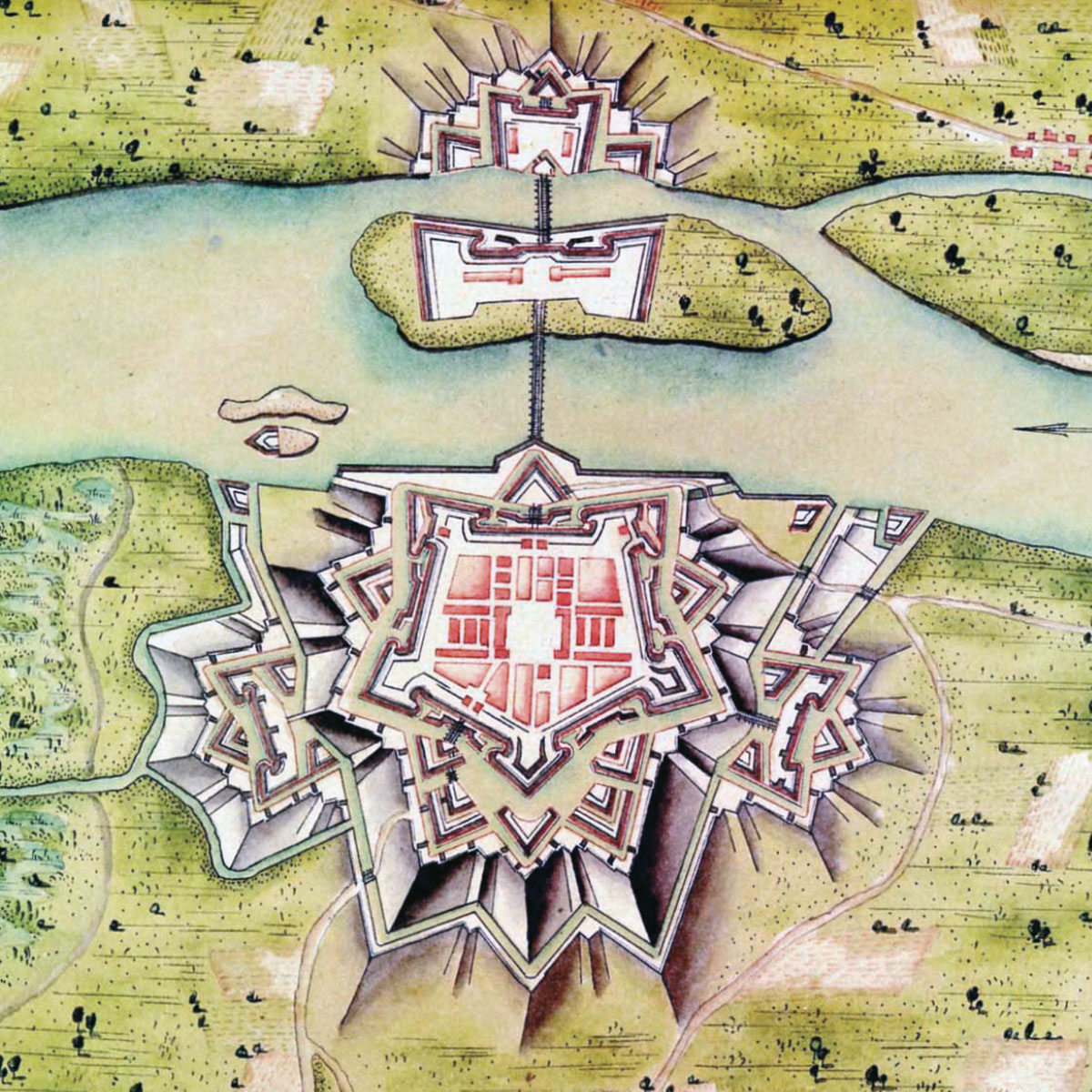
3 / Museum garden
This garden is both mine and Le Nôtre’s
We were both in good grace with the King! The King liked dear old André Le Nôtre for being a draughtsman of his parks and gardens, notably in Versailles. And I was liked for being the great defender of the kingdom’s borders upon which I built, or redid, many strongholds. What a shame that we never had the opportunity of working together since we were both very focused on detail and had the same interest in geometrical shapes!
This museum garden could have easily been the fruit of our joint efforts with the symmetrical flower beds, angular alleys and plant ornamentation, all inspired from French formal gardens.
From the main alley or the porch, or even from one of the alcoves which I imagined for my siesta, this little haven of tranquillity in the heart of the city unveils some lovely perspectives. Great for the troop morale, right?
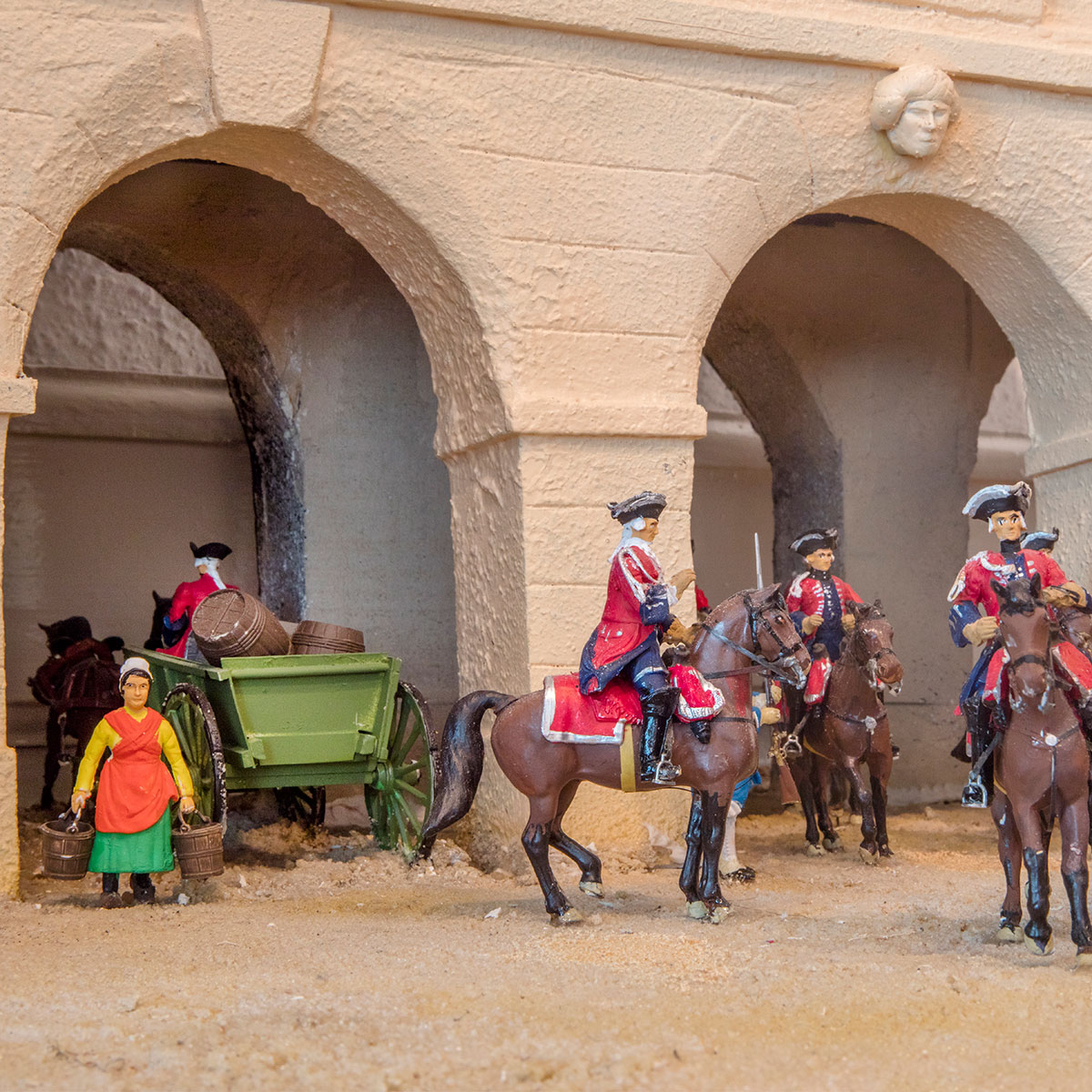
History
Everyday life
At the end of the 17th century, the Huningue stronghold had three thousand inhabitants. It was based around several trades necessary for its activity, as well as having well-established social classes.
Butcher, tailor, shoe-maker, wig-maker, upholsterer-embroiderer…. The daily life of master-craftsmen had certainly nothing in common with notaries or surgeons but it was enviable all the same. Just like that of innkeepers who earned money from soldiers drinking away their pay to relieve their boredom when they weren’t crossing the border to teach how to handle arms or music.
The oldest Basel fife-playing association is actually of Huningue origin!
While the garrison kept the city alive, workers survived doing the most tiresome chores for master-craftsmen such as shop-keepers, masons, gardeners …
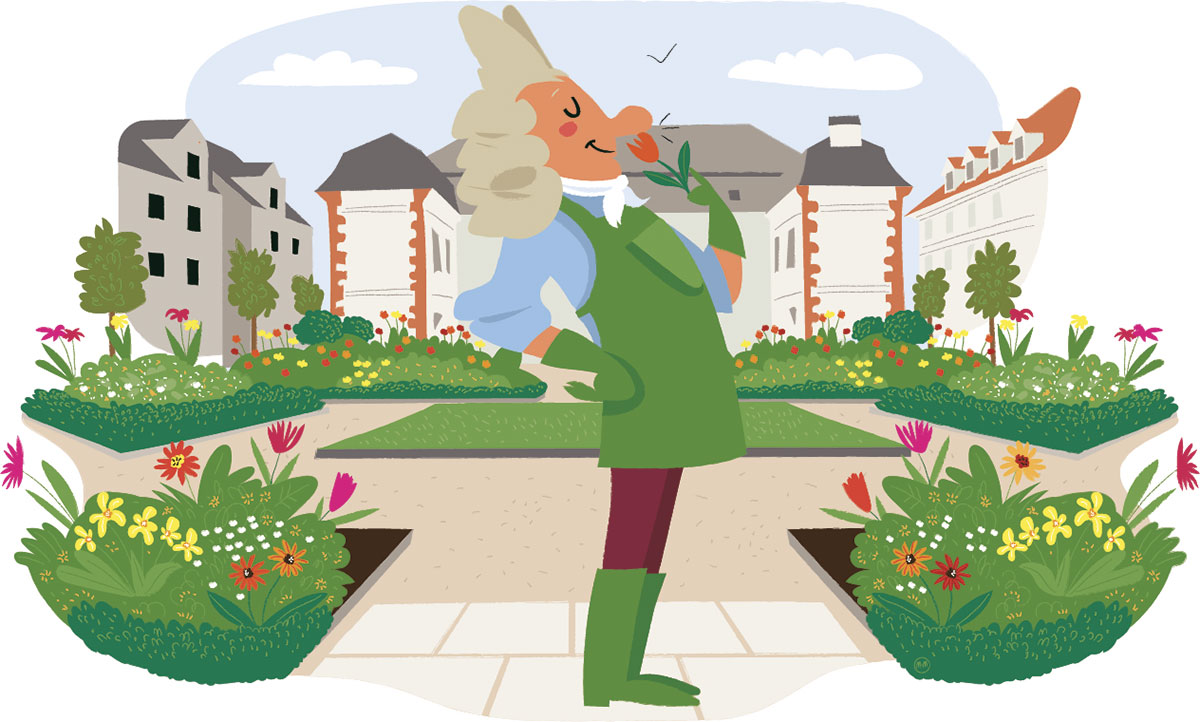
Historical and military museum
Located in the former home of the garrison quartermaster and war officer, the museum boasts, among other things, a beautiful collection of models, plans, engravings, portraits, letters patent, all retracing the three-century old history of one of the masterpieces of Vauban, its three sieges and its brave defenders.
Open on the 1st and 3rd Sunday of the month from 2:30pm – 5:30pm.
Closed on bank holidays and in August.
Group visits with French or German-speaking tour guide. Reservations mandatory :
03 89 89 33 94
4 / King’s tree nursery
The Soldier Tree
No regrets when I say that planting flowers for beauty’s sake never crossed my mind when I designed the stronghold during the 17th century! My only obsession at that time was to create something functional to provide for the needs of men, and to secure the defence and counterattacks when enemy canons started firing away. But nature was already my ally at the time as the trees surrounding the fortifications formed a first sort of shield against the projectiles, simultaneously producing wood to build, to heat or to be used for basketwork.
No regrets either as once the walls fell down the trees entered the city, and even more today thanks to the idea of the landscaper Michel Desvigne, who decided to plant a thousand trees around a new public outdoor area from the Rhine banks to the Place Abbatucci.
An area “at peace” where trees replace soldiers, a magnified place where the garrison has become the King’s tree nursery!
History
Around the bridgehead
Around 1680, rumours of a coalition project with the European powers worried the general staff in Versailles. The King ordered a reinforcement of the fortification ring around the kingdom.
Deeming the Huningue outer wall to not be safe enough, Vauban undertook the construction of a bridge and a bridgehead to make the fortress more defensive.
The workers started in 1684 on the left bank of Cordonniers Island, then in 1686 on the right bank.
At the end of 1697, the Ryswick Treaty signed between Louis XIV and the Holy Roman Empire established peace for over more than a century in the region but stipulated the demolition of the works on the right bank of Cordonniers Island and of the bridge.
History of the Huningue bridges
After the Vauban-built Bridge was demolished, a new one was built in 1702 allowing the Duke of Villars, future Marshal of France, to cross the Rhine to win a battle in Friedlingen against the imperial troops. This bridge collapsed two years later. The pontoon bridges built in 1721, 1742, 1746 and 1796 didn’t hold up much longer.
From one pontoon bridge to another
It was only in 1843, following an agreement between the grand duchy and France, that the Huningue flying toll-bridge began functioning. It was composed of two 60-metre spans starting from each bank with a raft in-between which was used as a ferryboat. The whole was dismantled in 1870 with the outbreak of the Franco-German war.
After the annexation of Alsace by Germany, the Bade region was connected to Reichsland Elsass-Lothringen by ten pontoon bridges of which the one furthest south was in Huningue. It continued to work during the First World War and up until the beginning of the Second World War. It was demolished in 1939 and was rebuilt by the Germans as of 1940. Fragilised by the Royal Air Force bombs, it was carried away by a flood in 1944.
The ferryboat
After the Second World War a ferryboat was commissioned between Huningue and Weil am Rhein which appeared unable to absorb the growing traffic. The Palmrain bridge replaced it further downstream in 1979.
The Passerelle des Trois Pays (Three Countries’ Bridge)
Since November 12, 2006, instead of these bridges, there the Passerelle des Trois Pays crosses the Rhine with a unique span of 238 metres. Designed by Feichtinger Architectes, this asymmetrically-curved, steelwork structure has been awarded some prestigious prizes such as the German Bridge Construction Prize (Deutscher Brückenbaupreis) and the most acclaimed international distinction, the Arthur G. Hayden medal.
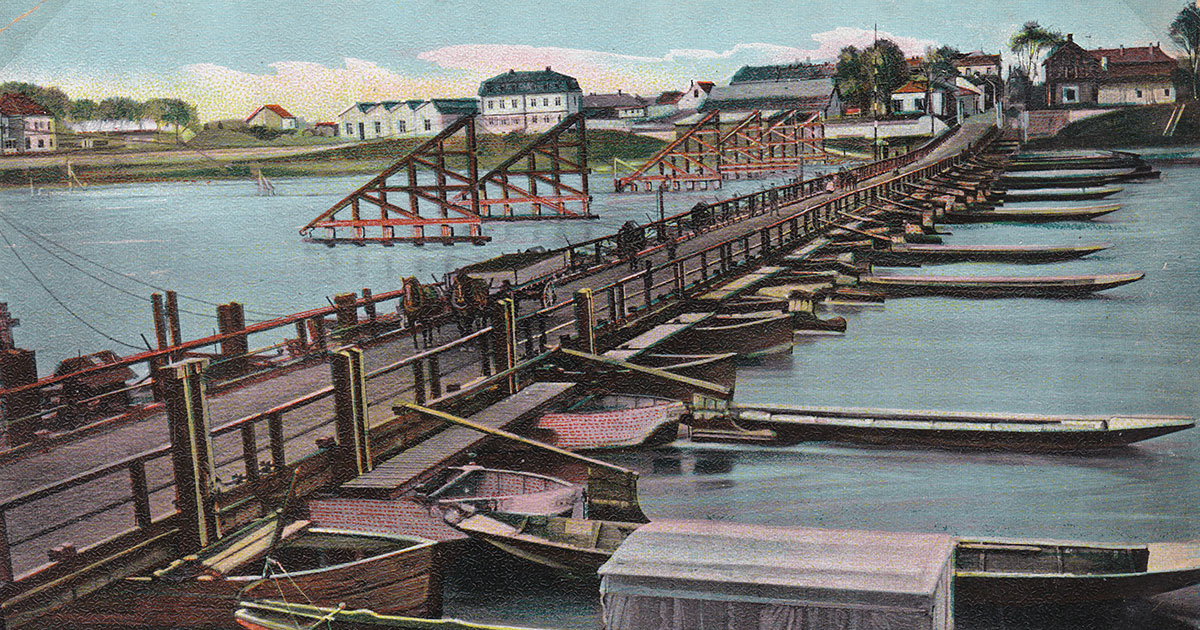
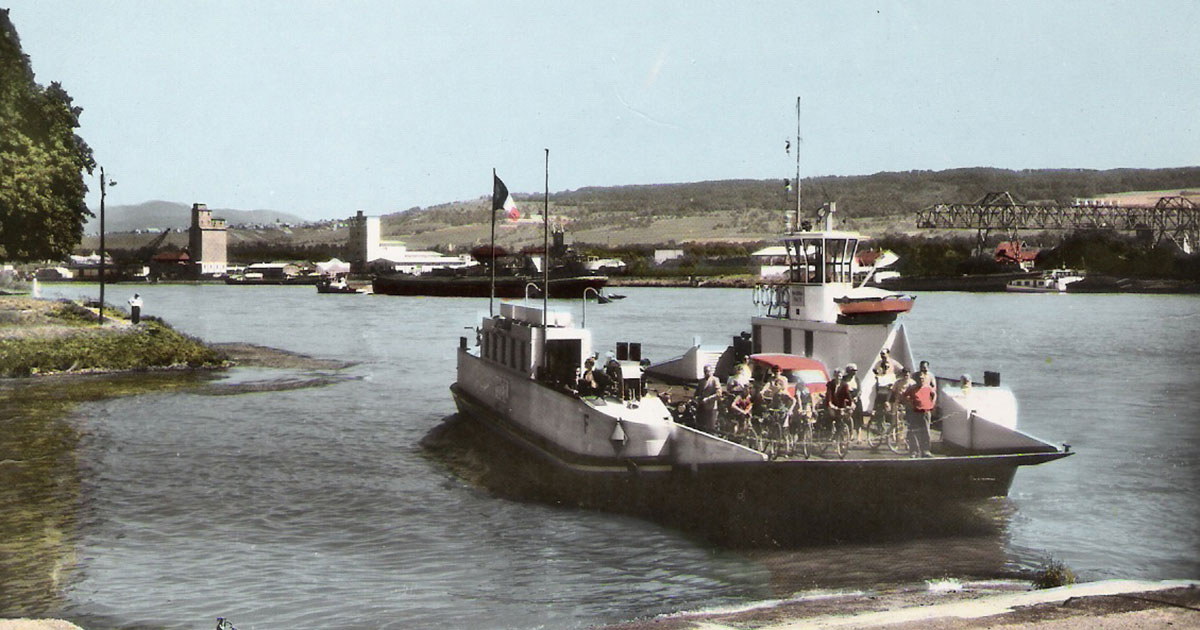
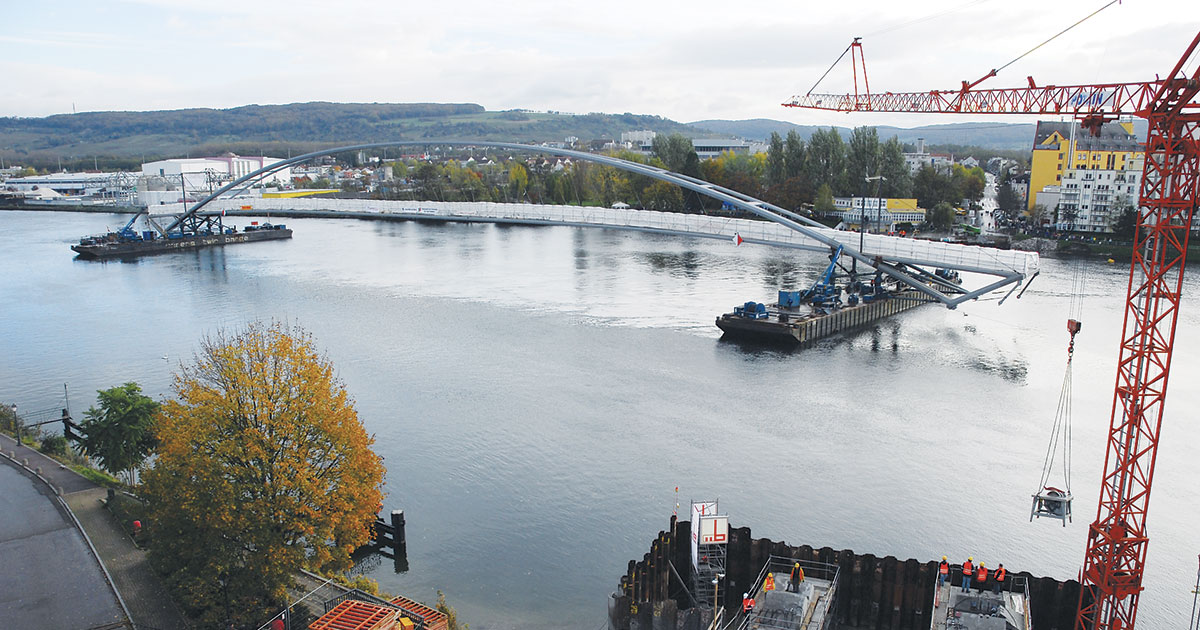
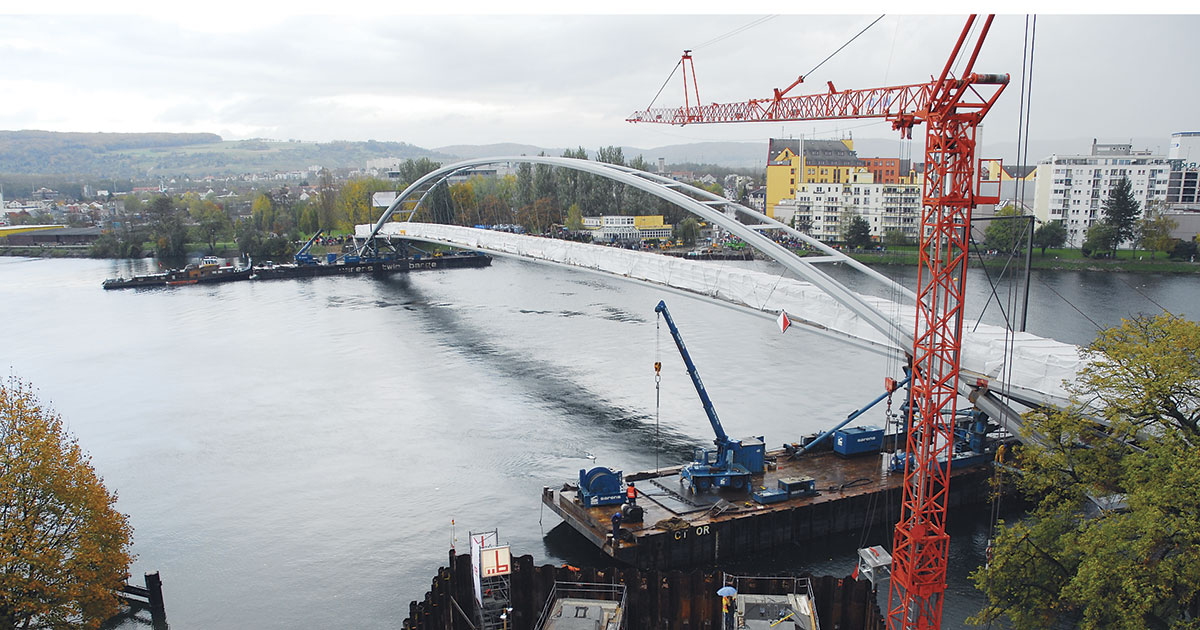
5 / Bird garden
Basel only a stone’s throw away …
You should know that during the 17th century, Huningue had engraved in its cast-iron cannons, “Basel if you move, we’ll burn you down!” The city really had nothing hospitable about it with the soldiers all shut away in the fortification …
Today we can truly mock this past when we see endless pedestrians and cyclists of all nationalities strolling around the city, and along the river which presently brings the cities and mankind together.
Also affected by this change, the Rhine has been an inspirational source for many poets. With its banks planted like before with willow trees and other marsh plants – feet in the water and facing the sun – it has once again become the refuge for endemic species on the Île du Rhin, such as the elegant goldfinch, the song thrush or even the great tit which I’ve had the pleasure of watching, pecking within these flowered, overgrown meadows, which serve as copious open-air feeding grounds … ideal during the winter!
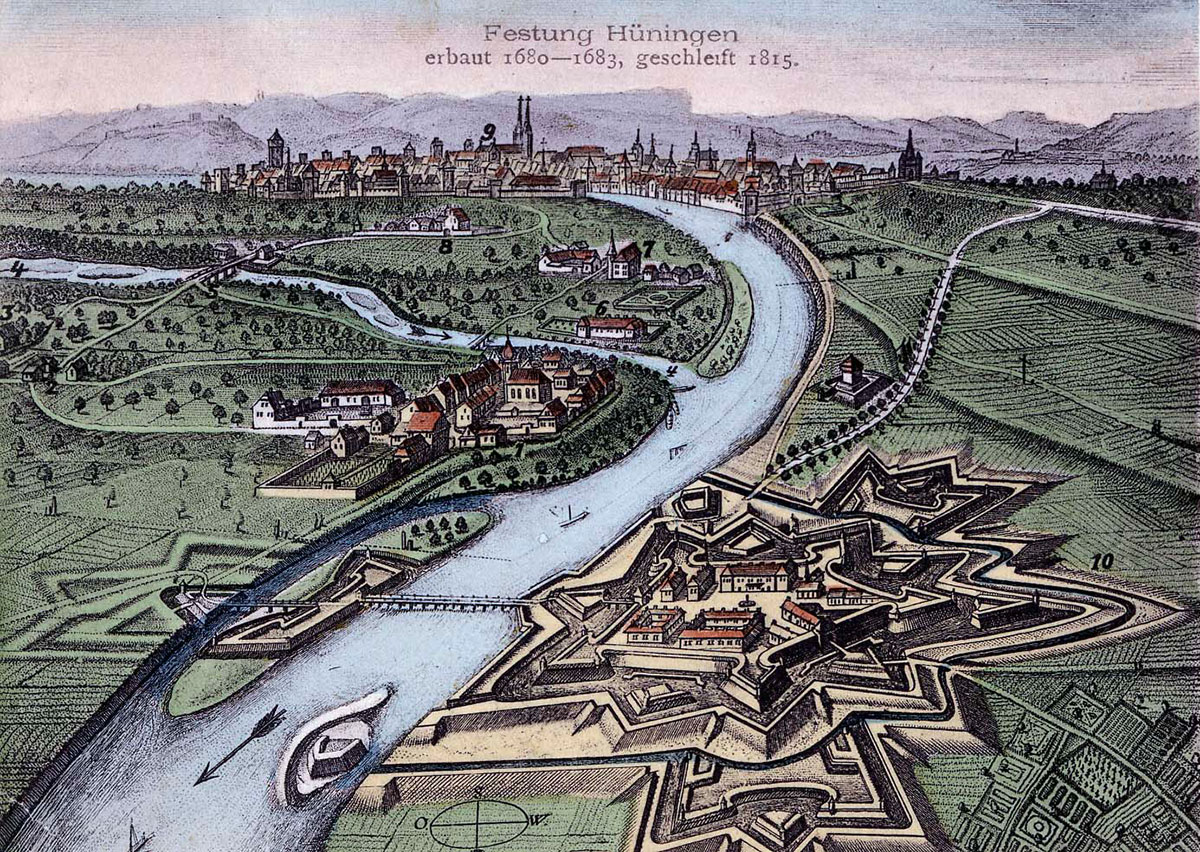
History
Huningue on loan
Pawned to Basel several years earlier by the penniless Habsburgs, Huningue became Austrian again in 1623 when the Archduke Leopold firmly asserted his rights to the Basel inhabitants who claimed the property as their own and didn’t want to sell it back.
The loan reimbursement and the promise of a financial compensation nonetheless dissuaded the Swiss from taking up arms.
Sold in 1638 to a banker who looked after the wages and the supplies of the imperial troops, Huningue became the barony of Grand-Huningue. This handover obliged the banker to pay damages to the heirs of Jean Conrad de Flachslander who proved they were already the owners: the Archduke Leopold has already sold Huningue to their ancestors as of 1623!
The Bale inhabitants then tried recuperating Huningue, at first in the name of the financial compensation which they had never received, and then by using diplomacy. In vain.
Losing this essential territory then became considered as a major loss as rumours were already spreading that Louis XIV was building some fortifications …
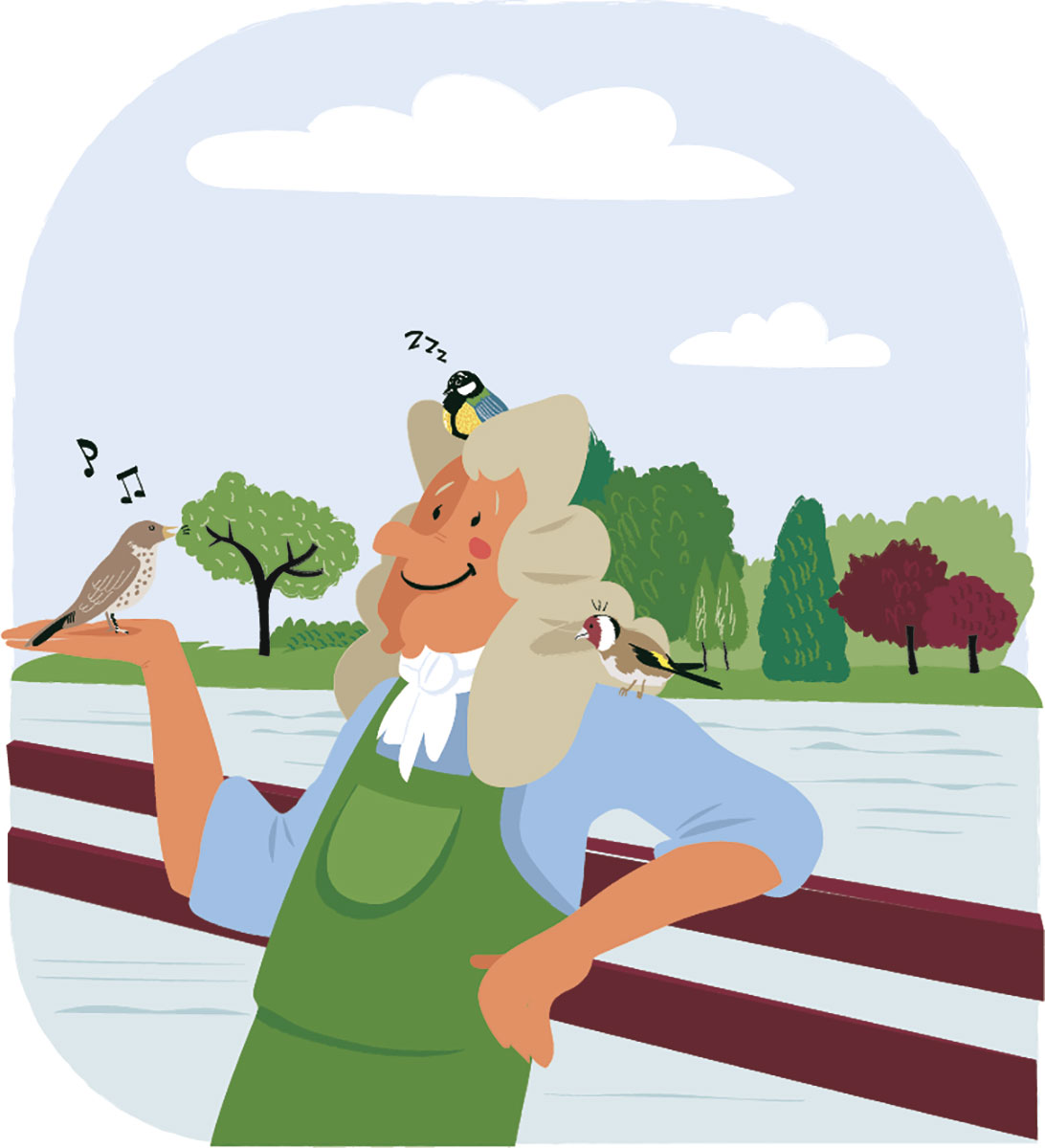
6 / Perennials garden
Flower power
Quite honestly, the ideal garden for me would be a little more chameleon-like with different flower varieties and colours for each season. But as a sensible gardener, just like for the hundred soldiers that I always preferred to save my king rather than take a thousand from my enemy, I prefer today to save the environment and the men rather than run out of our resources in the name of fashion.
With annual plants, which certainly inspire me, I wouldn’t chose as many whereas with perennials I can choose just as many simple and hardy plants for my flower beds.
Moreover these plants can resist all seasonal sieges, even the most difficult!
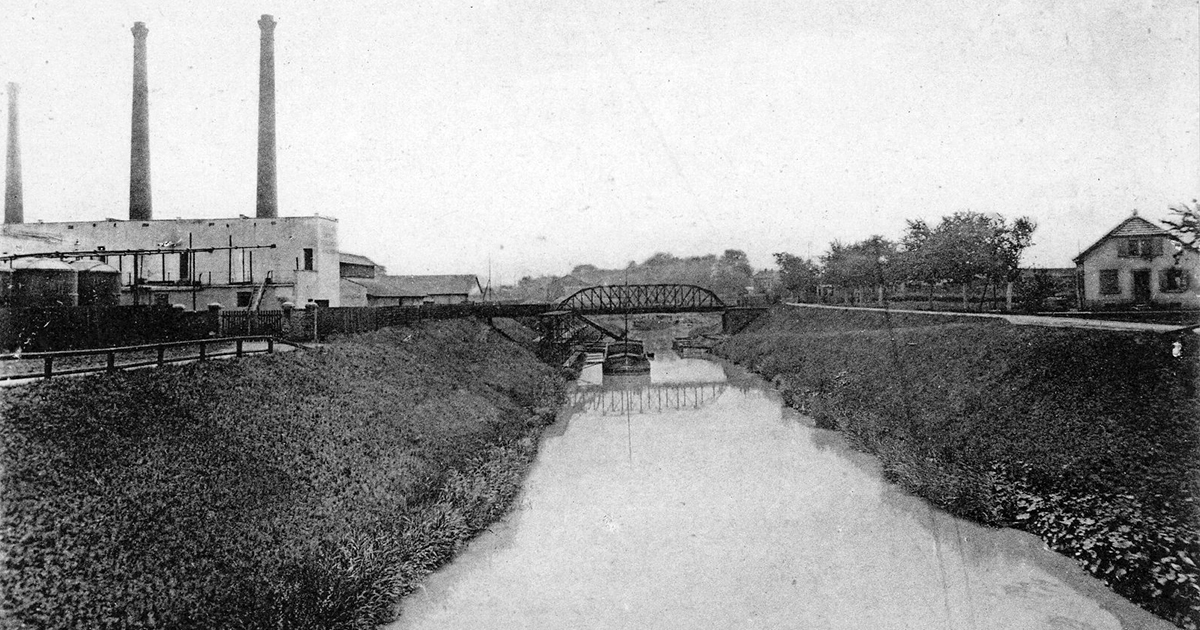
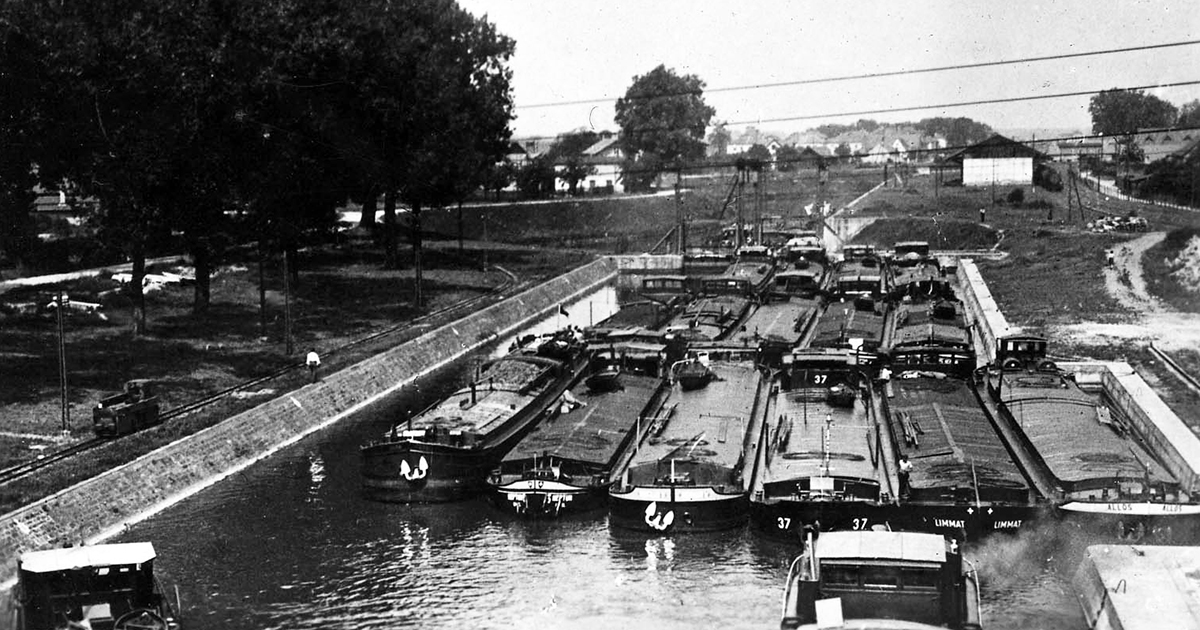
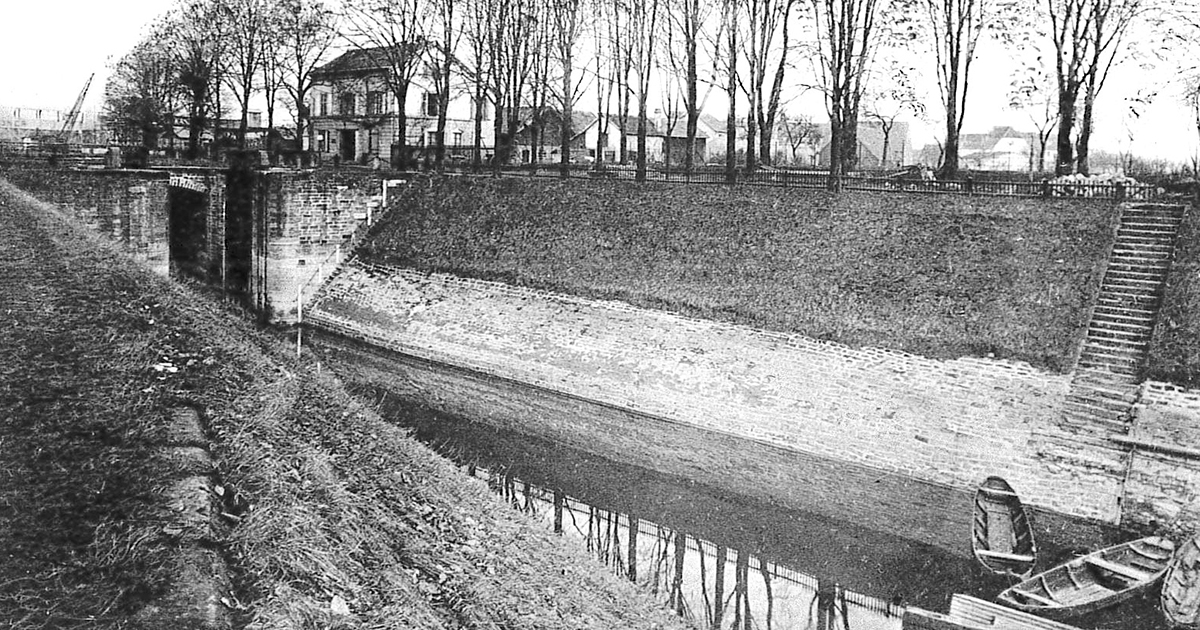
History
From the fortress to the canal: a new era
At the end of the 17th century, Vauban was already presenting the principle of a canal in Alsace, “a canal next to the river, separated by chambers and locks which could start at the end of Huningue’s fore-ditch and continue up to Strasbourg.”
The interest of a segment until Mulhouse – the Huningue Canal – wasn’t obvious however until the canal project of the Rhone to the Rhine, imagined in 1744 by Claude-Quentin La Chiche, a young officer from the Royal Engineering Corps. Although the objective of this junction of 28,086 km was to guarantee the feeding of the future canal, along with the Largue and the Ill rivers, it was immediately built between 1810 and 1833 with a navigable size and with locks.
It thus contributed to the flourishing of the Huningue port with all the traffic starting or stopping there as still unable to reach the Rhine lock. The towing then became electrified, making Strasbourg only four days away.
The drop in harbour activity after the Second World War anounced the downgrading of the canal for navigation, imposed by the commissioning of the Kembs-Niffer connection on the great Alsace canal in 1961.
The Huningue canal has since returned to its initial function of supplying water and earned the role of an ecological corridor, reinforcing the green infrastructure of this tri-national conurbation. The harbour wilderness has been transformed into the Parc des eaux vives, as a result of a reclassification operation finalised in 1993.
Botany
Long Live Perennial!
In the fields, forests, ponds and more and more in the urban gardens, hardy plants are everywhere.
Botanists describe them as being perennials which means they live for several years, as opposed to annuals or bi-annuals.
More specifically, horticulturists recognise herbaceous and semi-ligneous plants as being hardy plants. They fructify several times in a lifetime, disappear most often during winter, but their stems remain for a couple of years. Plants only stay perennial when placed in conditions similar to the country of origin. In Alsace, the continental climate requires plant species which can handle both freezing winter weather and summer heat waves.
Gardeners’ joy
As for gardeners, perennials are their pride and joy, embellishing their borders and flowerbeds for a long time with infinite combinations of colours and textures! They can thus avoid incessant planting, treating or watering, and simultaneously greatly enhance biodiversity.
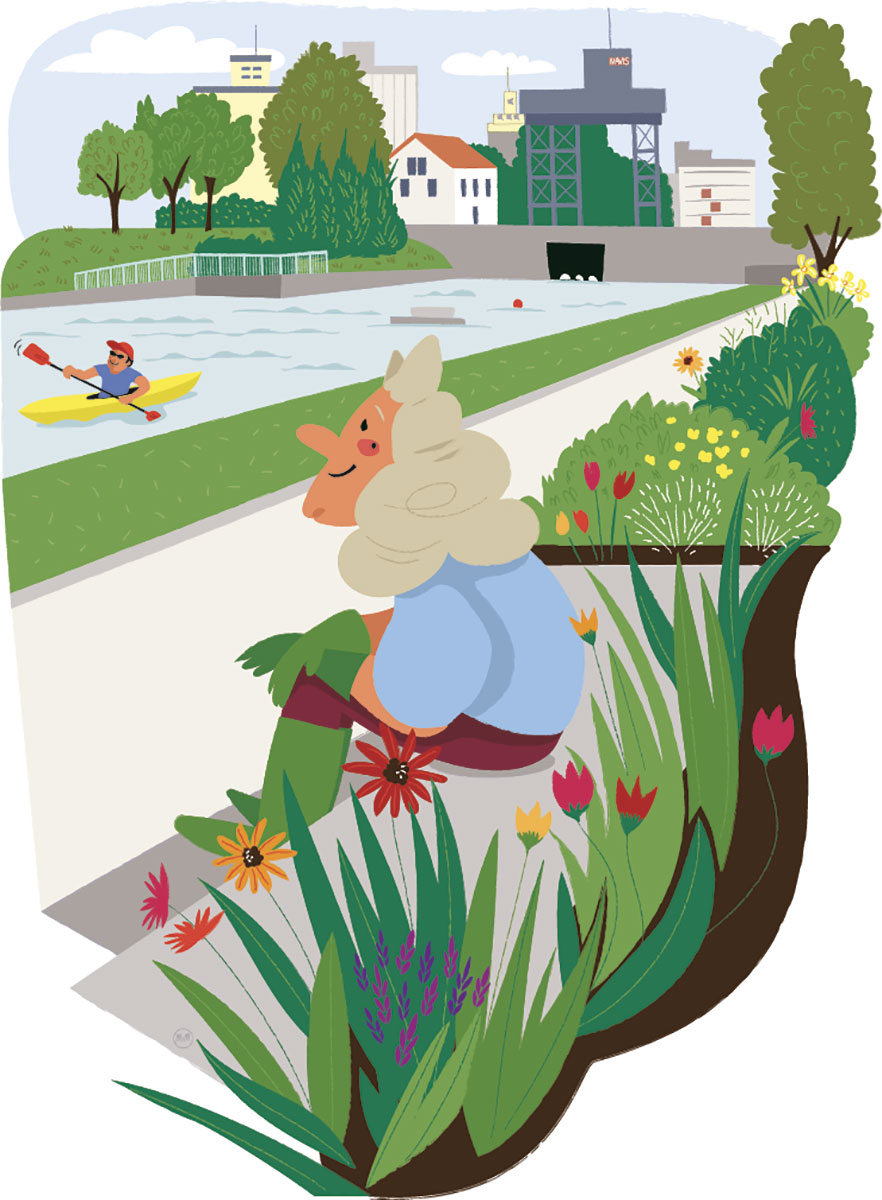
7 / Honey garden
Long live the queen!
I’m a weary-free traveller and know the rough country-roads and beautiful kingdom provinces down to the smallest hamlet. I’ve also experienced misfortunes and sometimes even famine due to decreased crops or from natural disasters, from what the lords and clergy took, and even from pillaging during wars.
Today agriculture has far better yields and feeds everyone. They say I’m a visionary… But I never imagined that bees which buzzed around our country-sides at one time are now being intoxicated and searching for refuge in our cities! Our productivity model certainly has some downfalls and among others, that of using way too many pesticides.
Standard-bearers of the little commonality of pollinating insects, bees excel at seeding pollen from flower to flower, thus safeguarding our food resources. We must protect them from poisons and preserve their environment. This is a new battle for me in our general interest… the king is dead, long live the queen!
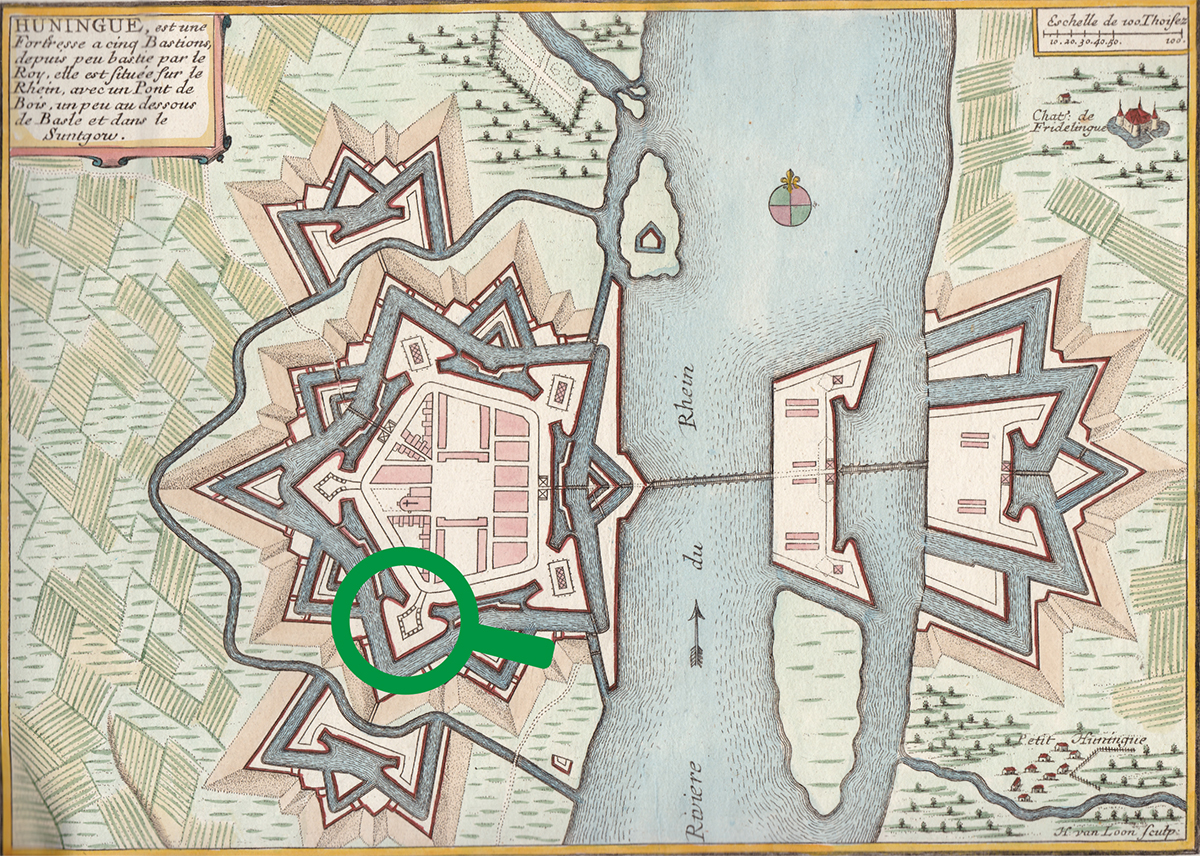
History
Remains of a bastion and its cavalier, the fortress mirador
An essential element of fortifications, the cavalier reinforced each bastion and allowed artillerymen to position themselves overlooking the walls to better counterattack the besiegers, or at least to block their attempts of approach.
Huningue boasts one cavalier among the rare remains of its stronghold, the one dominating the southern bastion with the plateau of Saint-Louis, Basel and the first Jura foothills in the horizon. Today an orchard and an apiary have replaced the artillery!
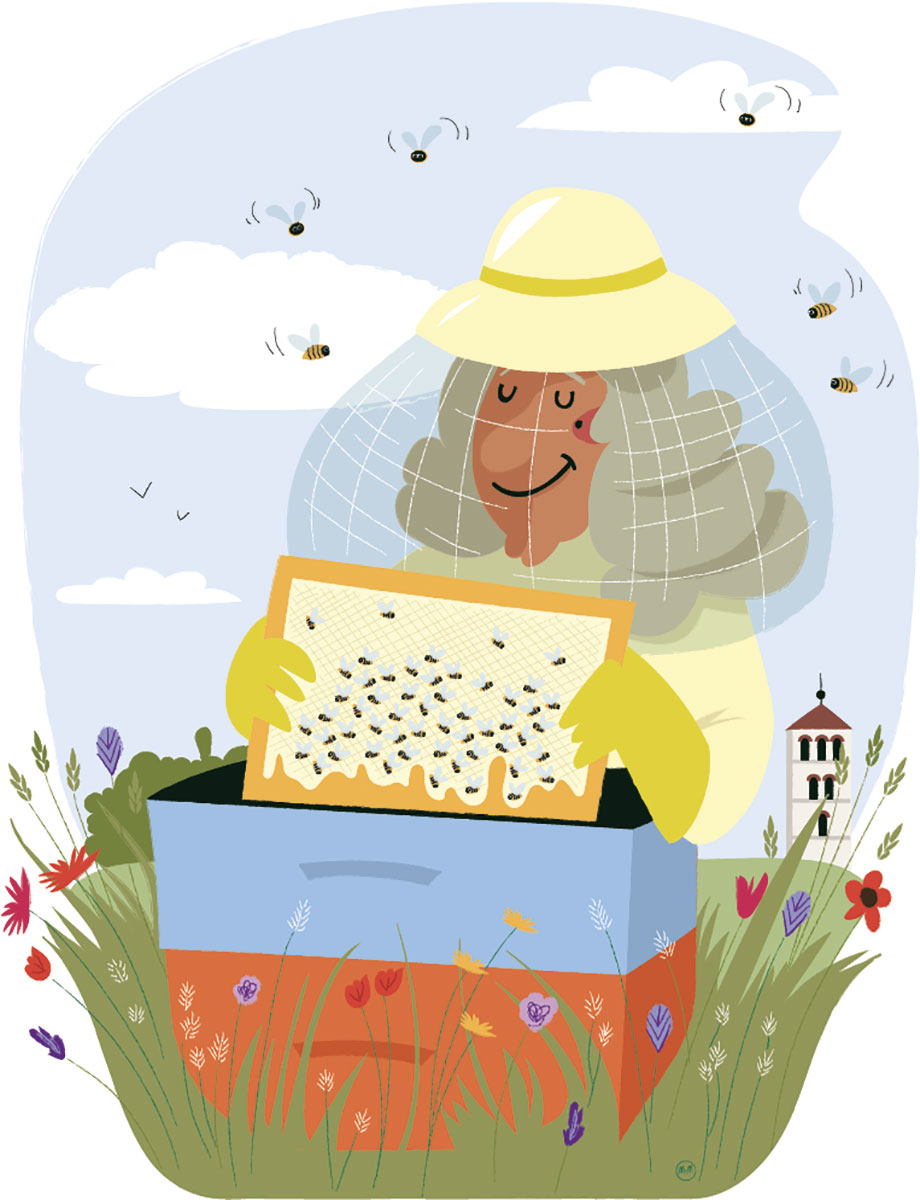
Botany
The virtues of an orchard
Symbolic of the local actions favouring biodiversity, the orchard on the Fetter butte (usual name given to the former fortress-cavalier overlooking the Parc des eaux vives) has about twenty pear trees, apple trees and other flowering trees.
These ancient or indigenous varieties were chosen for their resistance and ability to adapt to the region thus avoiding the usage of any chemical treatments.
With the blossoming meadow and surrounding apiary, this instructive learning site is an ideal educational base to practise tree-growing and honey-making techniques.
8 / Spawning grounds in the Parc des Eaux Vives
Huningue – a water city
There was only water around Huningue during the fortification period. Clear water, running from Hégenheim along wooden channels or otherwise drawn out from the groundwater, an endless supply in the event of a siege. And of course river water which flowed up to the surrounding marsh area. Prone to fog, this water was a source of permanent humidity with an unhealthy atmosphere within the ramparts where air had problems circulating. It even caused respiratory problems and fever.
Today water is just as present in Huningue but in a more healthful and vigorous environment…up to these pretty little spawning areas in the Parc des eaux vives which reminds me the marshes way back when!
Botany
A blue-green infrastructure
Huningue is very involved in promoting biodiversity by implementing a blue-green infrastructure, essential to the preservation, restoration or creation of ecological continuity.
The spawning ground within the Parc des eaux vives meets these objectives by using sediment banks which boost fish spawning – or nesting – by allowing fish to lay their eggs on the covering substrates or vegetation. These banks also help promote habitat diversification and create a transition area between the riverbank and the water, much appreciated by birds, insects and amphibians. Their reeds and other water-plants allow the matter to be filtered and settle as well as assimilating nitrates and phosphorus.
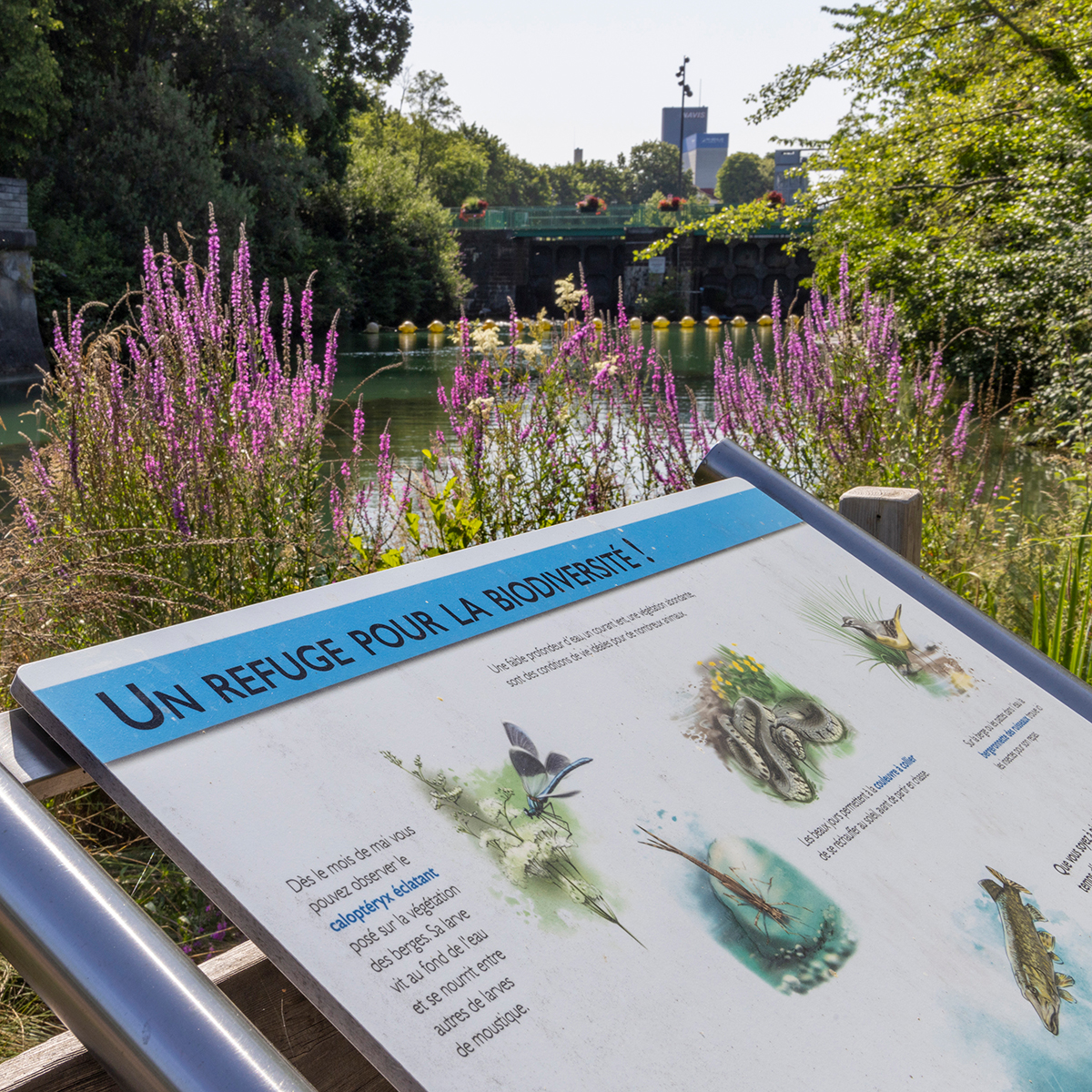
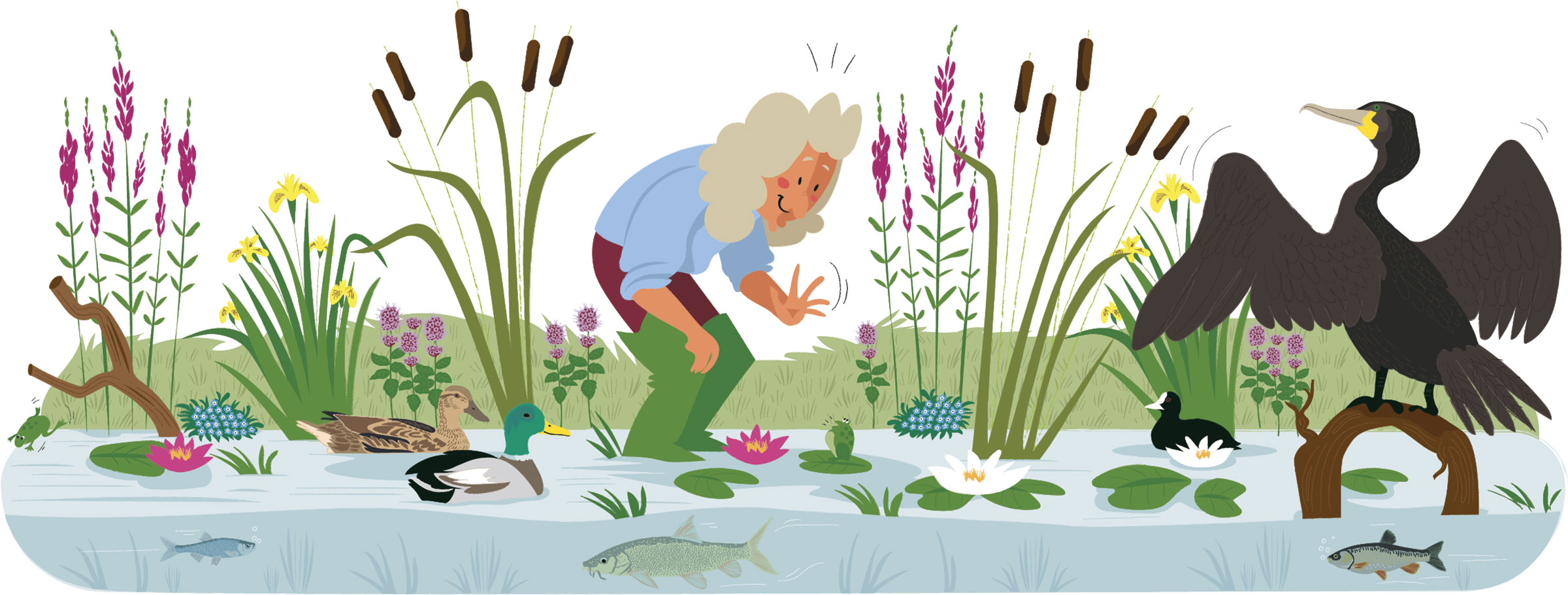
9 / Garden of fountains
Source of inspiration
Ditches, underground canalisations… the art of fortifying also includes imagining hydraulic solutions, a science which fascinates me. To the point that I undertook countless and innovative preliminary studies for drilling canals or raising embankments, spillways, flood barriers and locks, not only for military means but to develop the waterways so as to promote trade within the kingdom.
But hydraulics can be rather complicated, especially when the King requested me to provide the water supply to the castle and park of Versailles by building the spectacular Maintenon aqueduct!
There is nothing of the sort like that here in Huningue except some pretty water jets which nonetheless reveal my passion for fountains and make young children squeal with delight!
History
Huningue, from one port to the next
In 1816, the commissioning of the Huningue canal and numerous abandoned barracks from the former stronghold – perfectly exploitable as warehouses – gave the idea to build a large harbour establishment, able to attract Basel businesses who wanted to use this terminus.
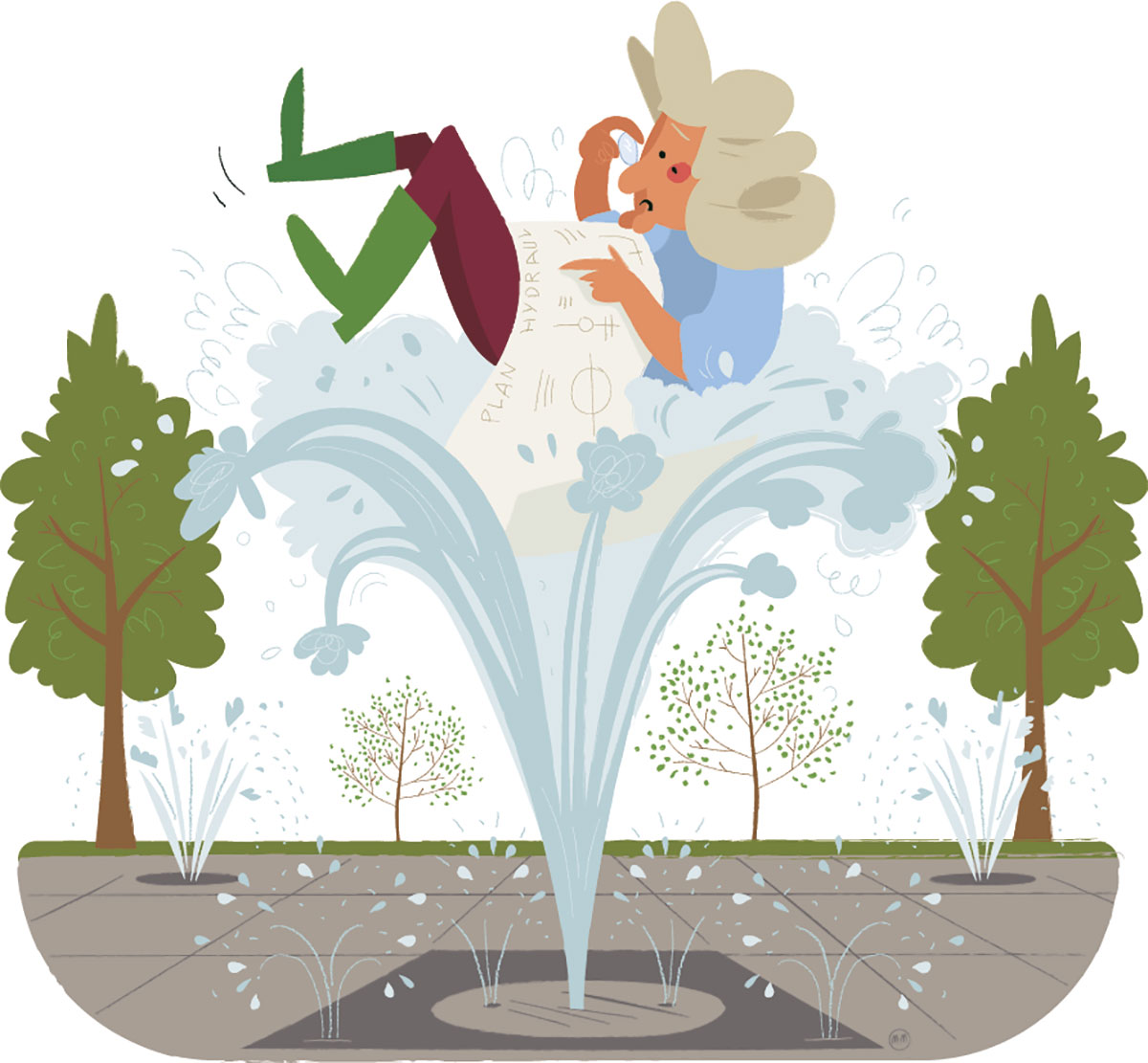
But in 1830, docks, cranes, and weighing scales were still lacking whereas exports towards Germany and Switzerland were on the rise, thus intensifying merchandise handling and customs controls.
Activity was still growing on the eve of the First World War thanks to canal renovation work which increased barge sizes from 200 to 300 tons. The port reached its heyday in 1935 with nearly 7000 boats travelling through.
But it was a short-lived prosperity, quickly overcome by the increasing competition with railways and from the building of lock n°1, allowing barges to reach Basel which was working on its own harbour development.
The creation of the new trade port on the great Alsace canal and the disqualification of the Huningue canal to navigation in 1961 definitely marked its end.
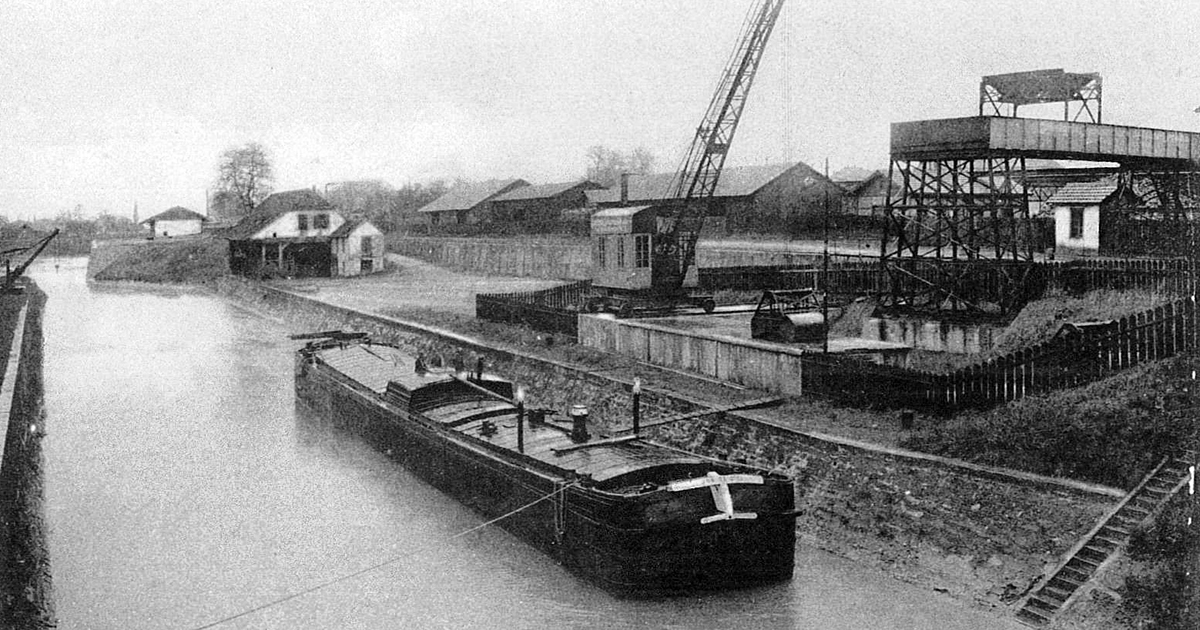
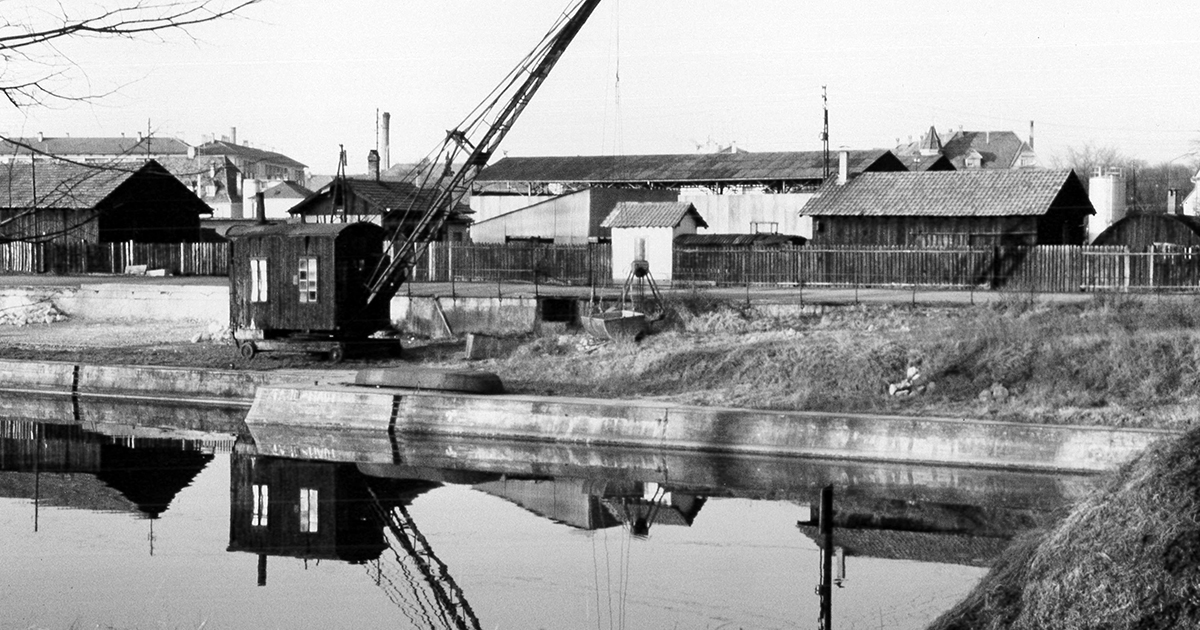
10 / The huningue imperial fish-breeding farm
Fresh fish
I would have loved to have participated in this first fish-farm experience in Huningue where it made the art of fish-breeding into a science. I would have rattled my brain to repopulate all our waters with trout, salmon, graylings and other freshwater fish by sending full crates all over the country full of fertilised and ready-to-hatch eggs.
And the most beautiful specimens raised in my ponds of pure water would all have ended, not on the King’s table, but on those of the too-often undernourished French population!
History
The history of fish-breeding
In 1852, under the reign of Napoleon III, the Huningue imperial fish-breeding farm was built on the Au site, in the heart of the present-day Alsace Petite Camargue.
It was the first industrial fish farm in Europe and benefited not only from quality water from the groundwater table but also from the proximity of the Rhine and its tributaries which at the time were full of fish and which provided millions of eggs. Incited by the government, these eggs were intended to repopulate the French and European waterways.
Today this fish farm participates in repopulating the Rhine within the framework of a program to reintroduce salmon. 300,000 varied-origin salmon eggs are incubated each year just like a small number of river trouts.
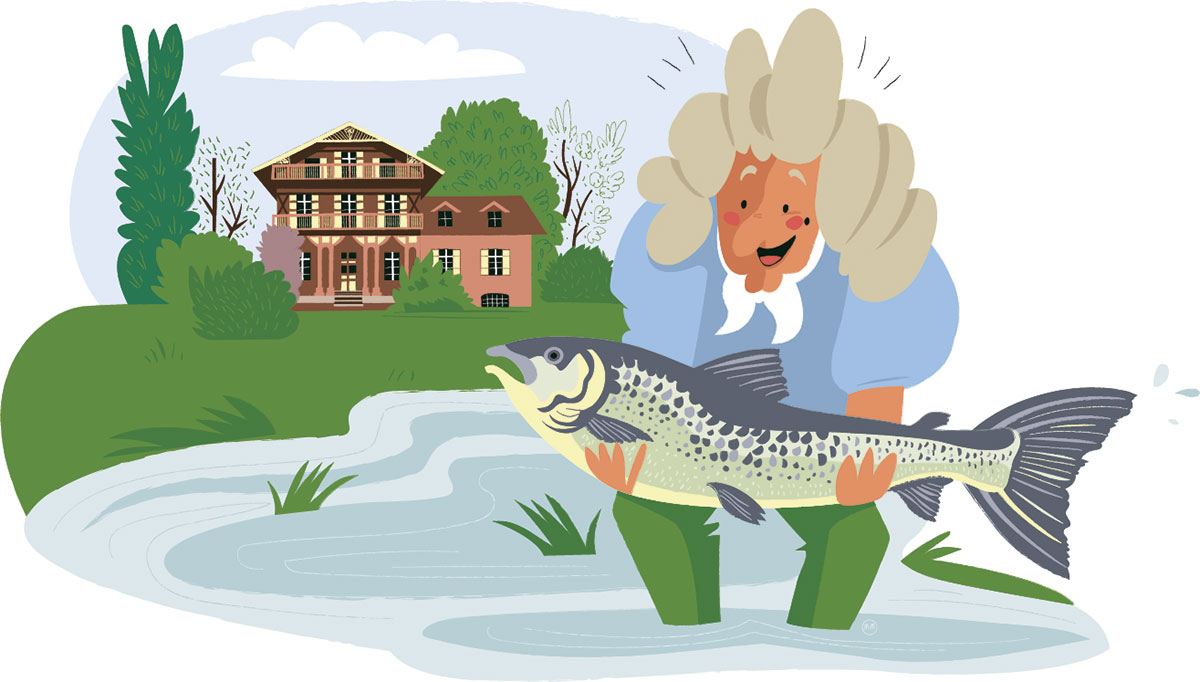
Botany
The Alsace Petite Camargue
Since 1982, the Au marshes, rare witnesses to the Rhineland jungle, have become the first protected nature reserve in Alsace, and since 1952 commonly referred to as the Alsace Petite Camargue.
The reserve spreads out over 904 hectares and is home to an Initiation Centre to Nature and the Environment (CINE), the “Saumon 2020” fish farm as well as a base for research and species monitoring, in partnership with the University of Basel and the National Centre of Scientific Research (CNRS) of Strasbourg.
11 / Nutritious garden
Vegetable patches
Long ago, bread, spelt or wheat, wine (actually young and acidic plonk!), salmon, pike or eel, fished in quantities in the surrounding area, was the daily ration of soldiers in Huningue. Fairly good meat was also on the menu as well as top-quality fresh vegetables such as potatoes, cabbage, peas, beans, various types of turnips …
The small vegetable gardens that I imagine today in each garden, on each terrace, basically in all the nooks and crannies of the city, would have also improved daily life at the time and avoided overwhelming nutrient deficiencies.
As today we are fully aware that eating vegetables is beneficial for the health thanks to their micro-nutrients so essential for our body.
History
Feeding a garrison when under siege
Even before the lack of food, malnutrition is the major enemy within a besieged stronghold as it jeopardises the health of soldiers who should be fighting. So any good strategist will therefore ensure that supplies are plentiful.
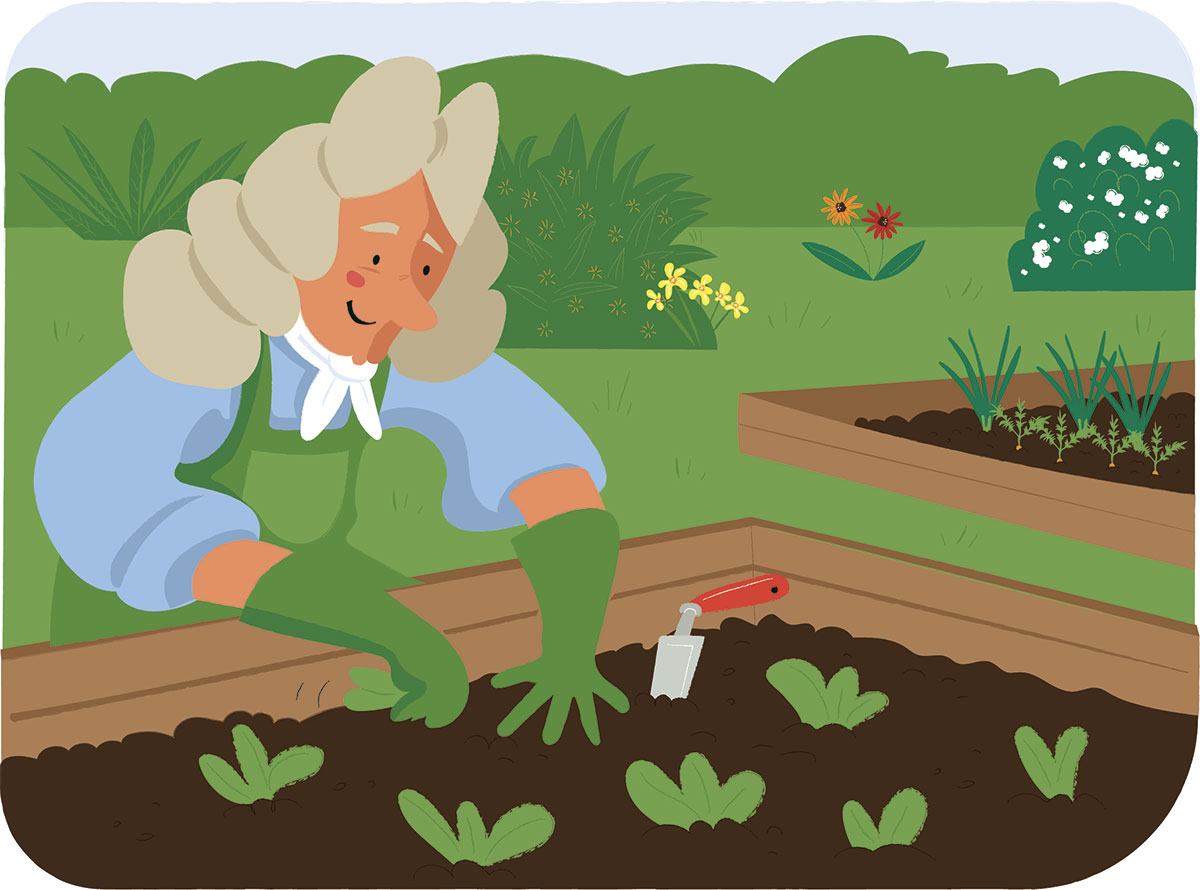
The stocks of flour must therefore guarantee fresh bread for a long time. Biscuits, dried or fermented vegetables, onions, garlic, fat and oil, potatoes which are already massively grown in Alsace, salted meats… as well as a large number of live animals for the expected duration of the siege. The military quartermaster and health officers regularly check food quality to replace any rotten ones.
Water was essential and in Huningue this wasn’t a problem with its endless supply. At this time both wine and brandy were also considered essential during a siege!
Subsistence crops
After the demolishment period, Huningue was in ruins. In 1816, the military administration lent the ditches and ramparts from the former fortress to the city. Each family could therefore farm a little piece of land in an attempt for survival. But during this time of extreme food-shortage, those who planted didn’t always reap what they sowed!
12 / Pyramid Park
Made of trees
I closely followed the building, improvement and maintenance of the stronghold down to the smallest detail, with the same diligence that I use today to preserve the trees and check their phytosanitary condition. My new occupations lead me to carefully check each one from the top to the bottom. Sadly, I must sometimes pronounce a fatal diagnosis for one of these beauties which can be in the prime of life.
It always breaks my heart to see one of my comrades fall, whether they are on the side or standing alone. But rather than bestowing a posthumous medal, I quickly replant a young shoot to perpetuate the tree-filled soul of our city.
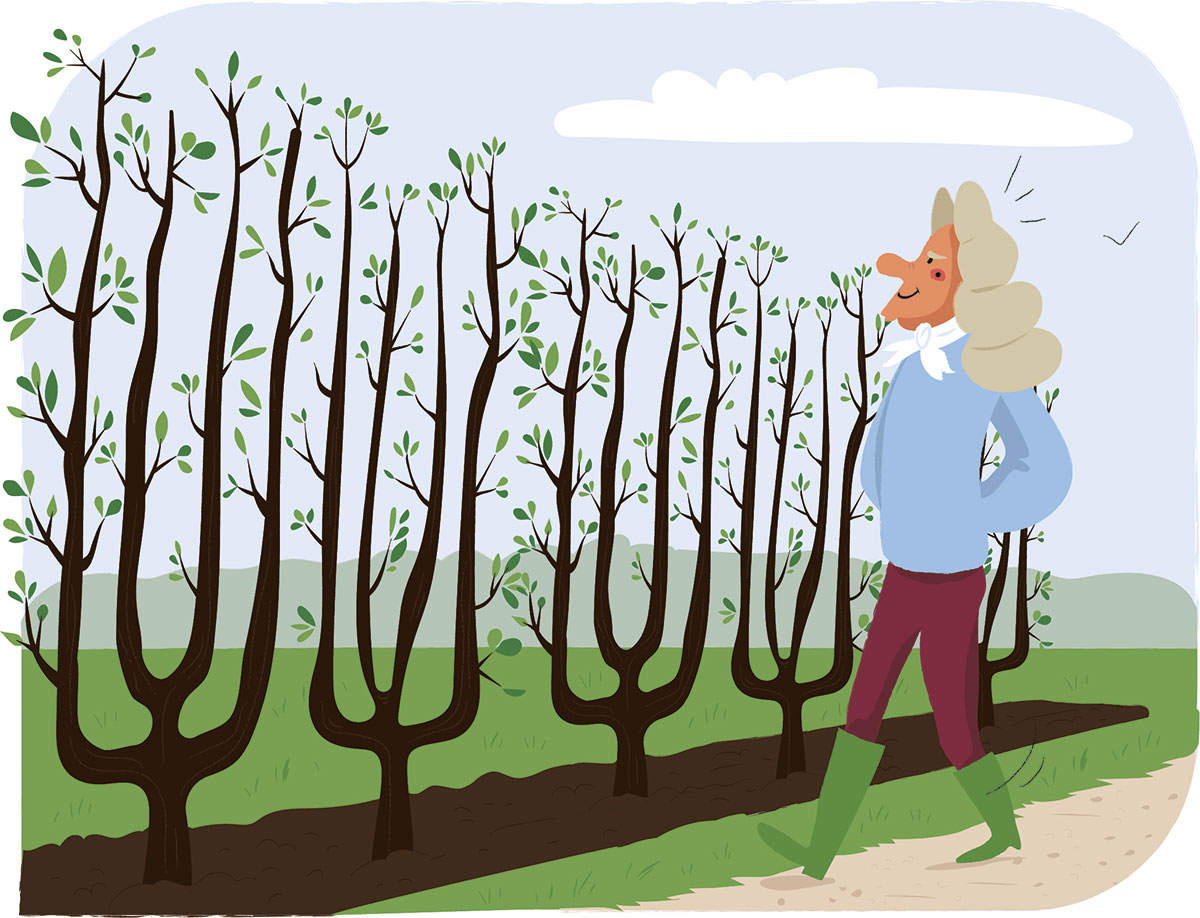
History
The great defenders of huningue
1796, 1814 and 1815: the strong hold was besieged three times, under the command successively of General Abbatucci, Colonel Chancel and General Barbanègre.
Abbatucci the brave
In June 1796, the command of Huningue was entrusted to a young brigadier general Jean Charles Abbatucci (1770-1796), already recognised for his brilliant feats of arms. Being that Huningue was a strategic gateway to France in Upper Alsace, the stronghold was quickly besieged by the Austrians. The general and his men resisted to thousands of assailants. Attempting a daring outing during the night of November 30 to December 1, the bloody battle continued with hand-to-hand combat. Fatally injured while defending the bridgehead, General Abbatucci died on December 2 at the age of 26.
A first monument honouring the memory of this Corse-born general from Zicavo, was built in 1801. Destroyed by the Basel population in 1816, it was rebuilt in 1830. It has sat in the centre of the Place Abbatucci since 1904, and was restored in 2013.
Chancel the resistant
In December 1813, the colonel Jean-Hugues Chancel (1766-1834), commanding officer of the stronghold, refused the advantages offered by the Austrians in exchange for handing over this fortress. The enemy troops therefore attacked Huningue which courageously retaliated for three months.
This is the least known, but the longest and most horrendous of the three sieges suffered by the fortress.
Barbanègre the hero
Surrender of the Huningue garrison on August 20, 1815 – Edouard Detaille
In 1815, the mission of General Joseph Barbanègre (1772-1830) was to defend Huningue without complying to the summons of this adversary, the Archduke John of Austria.
At this point the stronghold was lacking in both supplies and men. For two months and with only 135 able-men, he resisted to the enemy assaults boasting over 20,000 men and their destructive bombings. He only surrendered after 12 days of trench combat and the abdication of Napoleon I, and was awarded all the battle honours.
The capitulation of the fifty or so heroic survivors, led by General Barbanègre, was immortalised around 1892 by the painter Edouard Detaille. Today the original painting can be seen at the Senate in Paris.
13 / Water tower
A reliable source
In the 19th century, the water tower witnessed an unscrupulous industrial era regarding water usage which was heavily consumed and polluted. Decades later, the catastrophic consequences made people very aware of the urgency to preserve this vital resource!
My fight is to raise collective awareness regarding the importance of protecting water, already by using a different garden know-how: banning nitrates and pesticides, using mulch instead of over-watering or recuperating rainwater which saves the groundwaters.
Many other daily habits can contribute to the healthy transmission of a common heritage which is becoming rarer but essential for the survival of future generations!
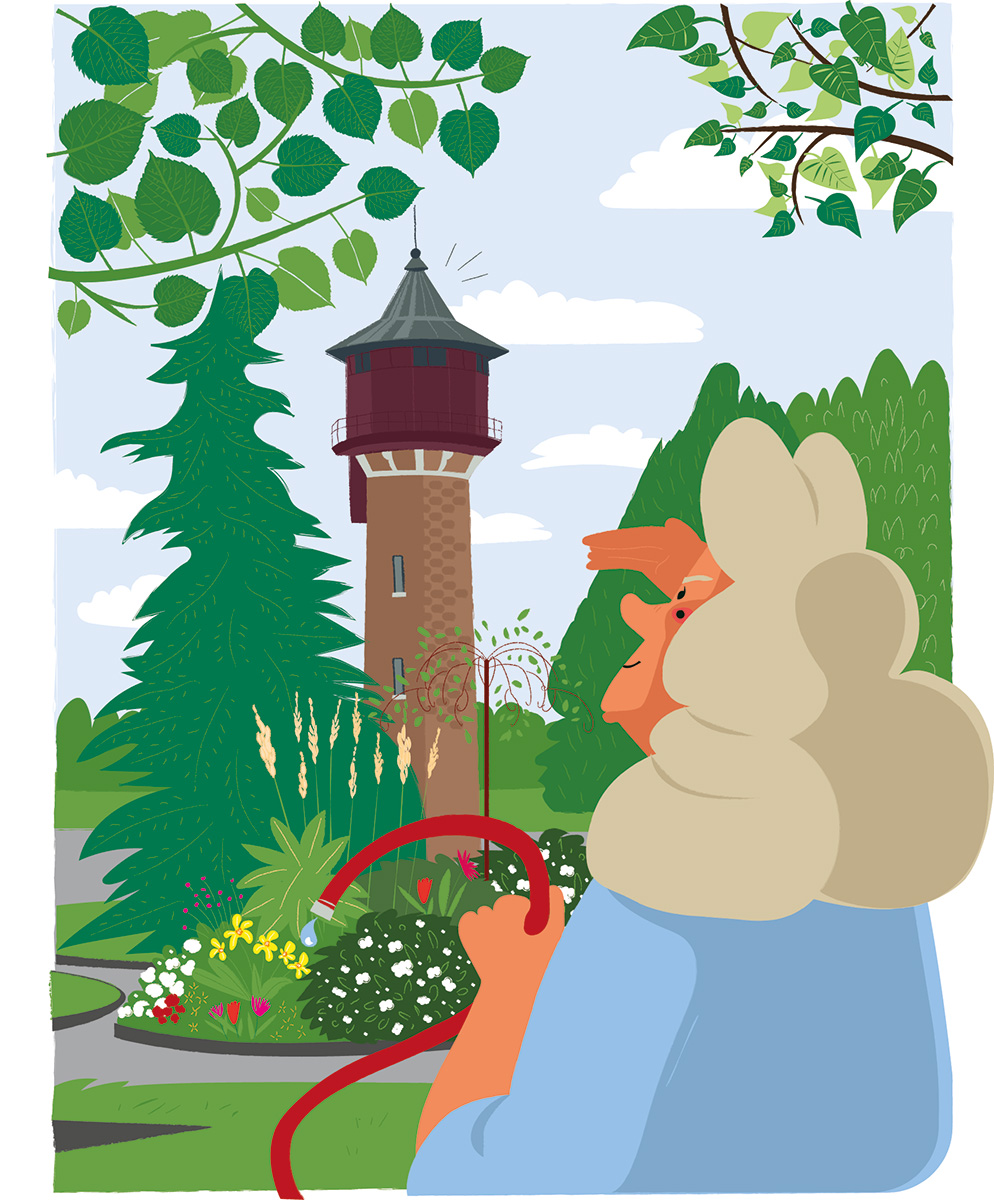
History
Huningue, an industrial city
In 1871, Alsace became German. With Huningue being no longer a border city, the garrison left, which had negative trade consequences, as the soldiers kept the businesses alive. The population slowly dwindled down to some modest workers employed in the Basel factories or on the right bank of the Rhine.
However, a few years later Huningue experienced rapid industrial growth helped by some favourable circumstances such as having Basel as it wealthy neighbour! But also the presence of large wastelands left after the demolition, the canal or even its endless water supply which industries used in quantity, explained this development.
Manufacturers slowly built up around the city, the latter selling off areas left over from the fortress remains at their profit. The pioneers were mostly branches of Swiss companies who wisely settled down here, enabling to enter the German market without paying the extremely-high customs tax which the Second Reich placed on imports.
Silk and watch makers as well as tobacco manufactures were among the major activities.
Life conditions progressed in a spectacular manner with improved sewer systems, gas-fuelled public lighting, then as of 1908 with electricity, which improved the life conditions of its 3000 inhabitants. The tramway even provided a direct ride towards Basel from 1910 to 1961.
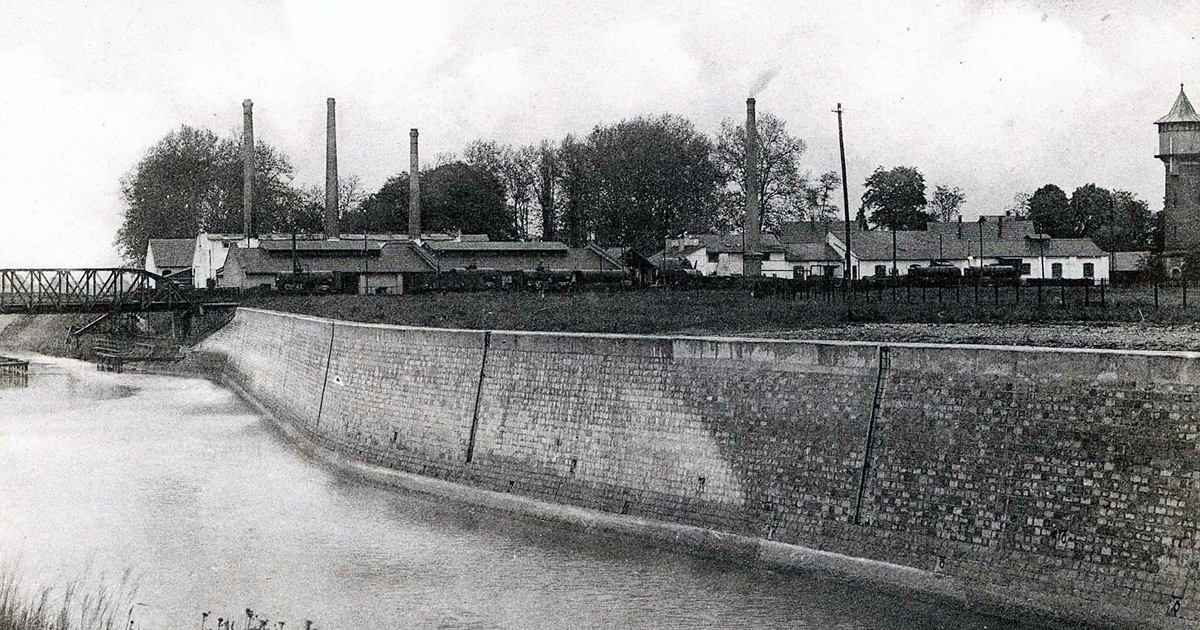
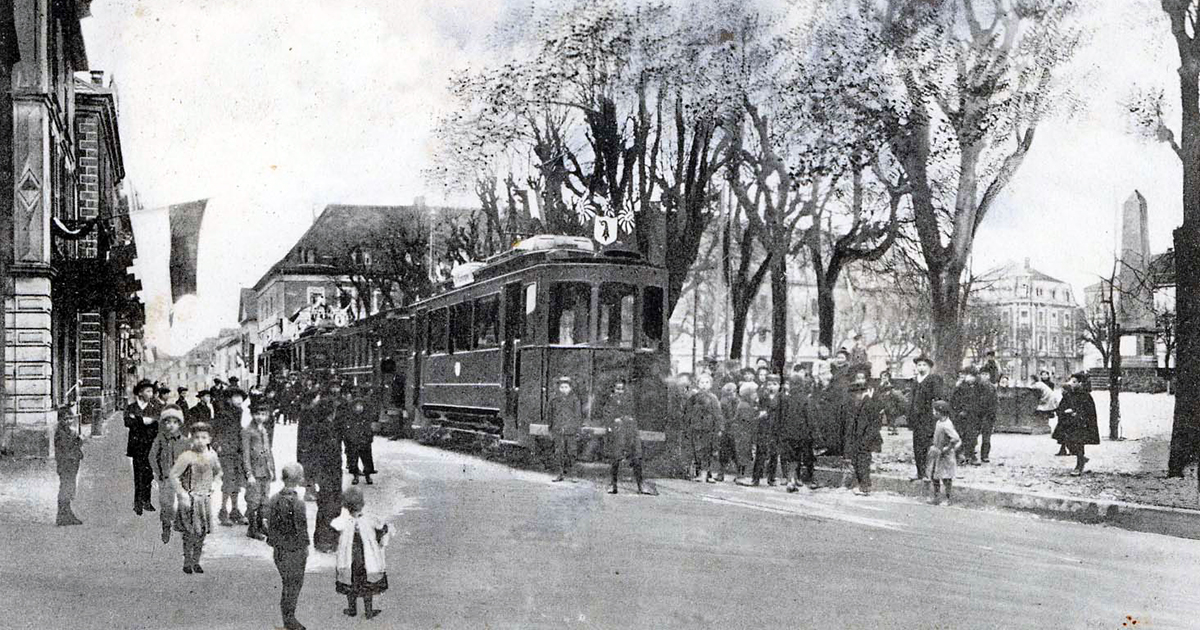
Botany
Biological fight
Encarsia formosa, Aphidius or even Chrysopa… are our garden allies to fight against invaders!
Often hardly visible with the naked eye, these predators of aphids, whiteflies and other parasites nevertheless have some impressive weapons. The miniscule Encarsia wasp lays its offspring right inside the whitefly larva, which are sap-suckers. Whereas the Chrysopa devours up to 50 aphids a day! Thanks to them, pesticides and insecticides become useless. This biological “integrated” protection allows to ecologically fight against parasitic attacks.
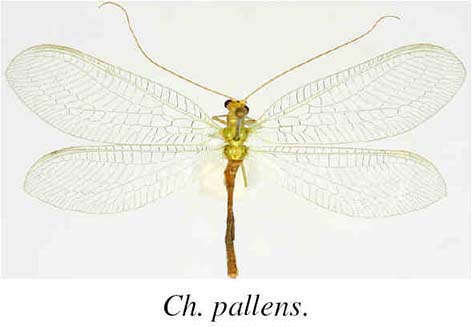
14 / Grazing garden
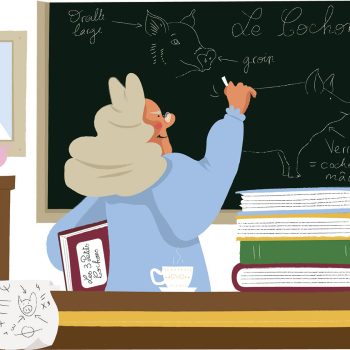
You have my word on it!
I have always sought to facilitate the living conditions of soldiers and the poor, which has piqued my curiosity in many different fields. Don’t repeat it but I even became interested in the pork-business and actually calculated that the offspring of just one sow would be enough, after twelve generations, to feed the whole of Europe!
I thought that developing pig-breeding would have been a good way of improving the life of local farmers who were overburdened with taxes, debt as well as being undernourished.
It wouldn’t take much for me to be considered as the inventor of intensive farming but today I am in favour of small-scale farming, shorter supply chains and enjoy eating a good plate of lentils to get my proteins!
History
Remains of a demi-lune
The demi-lune (or ravelin) is a fortification structure thus called as initially it was more rounded.
The demi-lune (or ravelin) is a fortification structure thus called as initially it was more rounded. Along with the tenaille located behind, it creates elements traditionally called the outworks. Detached from the stronghold itself, like a sort of island in the ditch, it alternates with the bastions lying above them to cross its fire with that of the bastion.
As it is isolated and non-protected on its back, “winning” the ravelin was in no manner considered a decisive advantage for the attackers being that they had difficulties maintaining and placing their artillery.
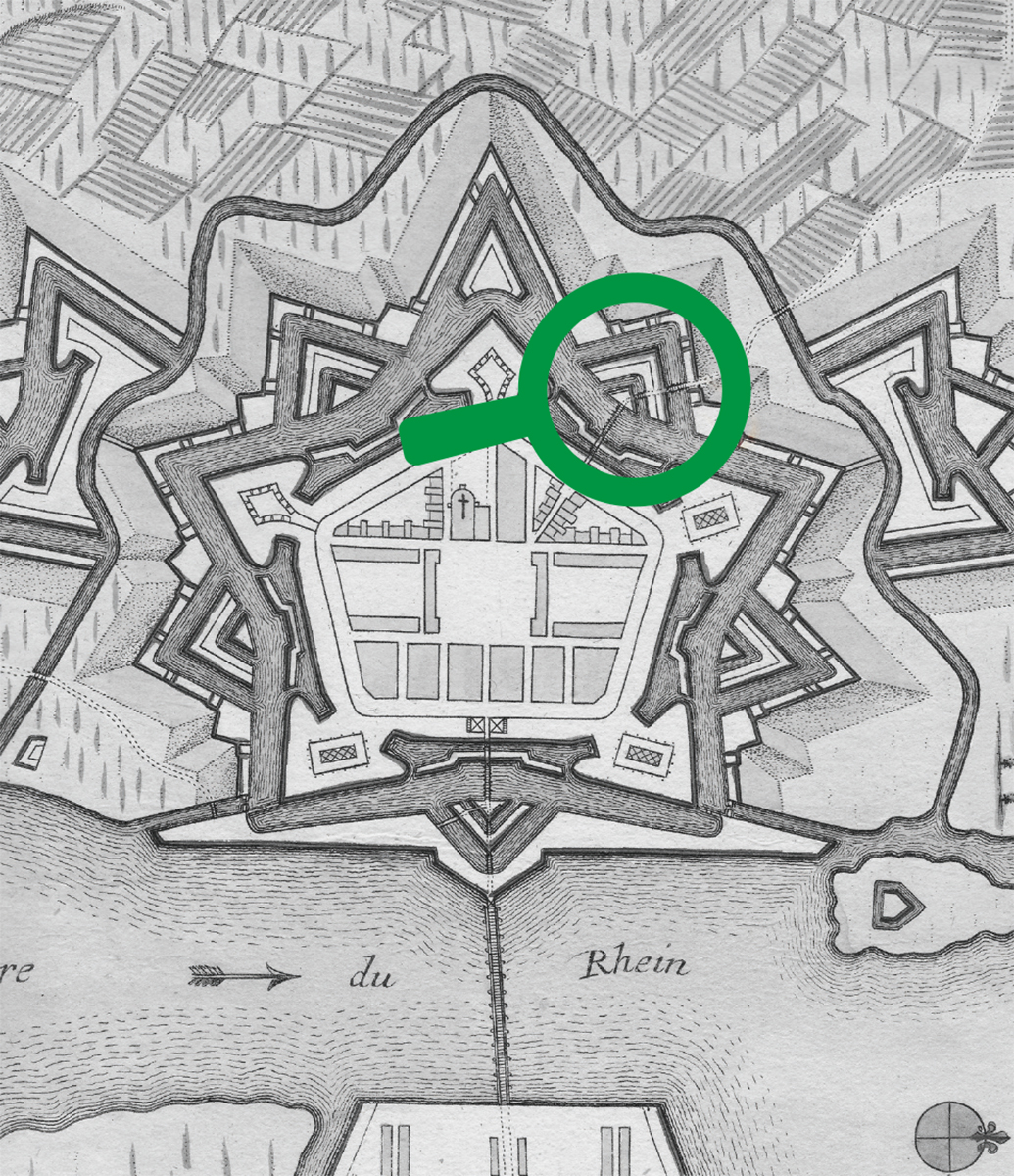
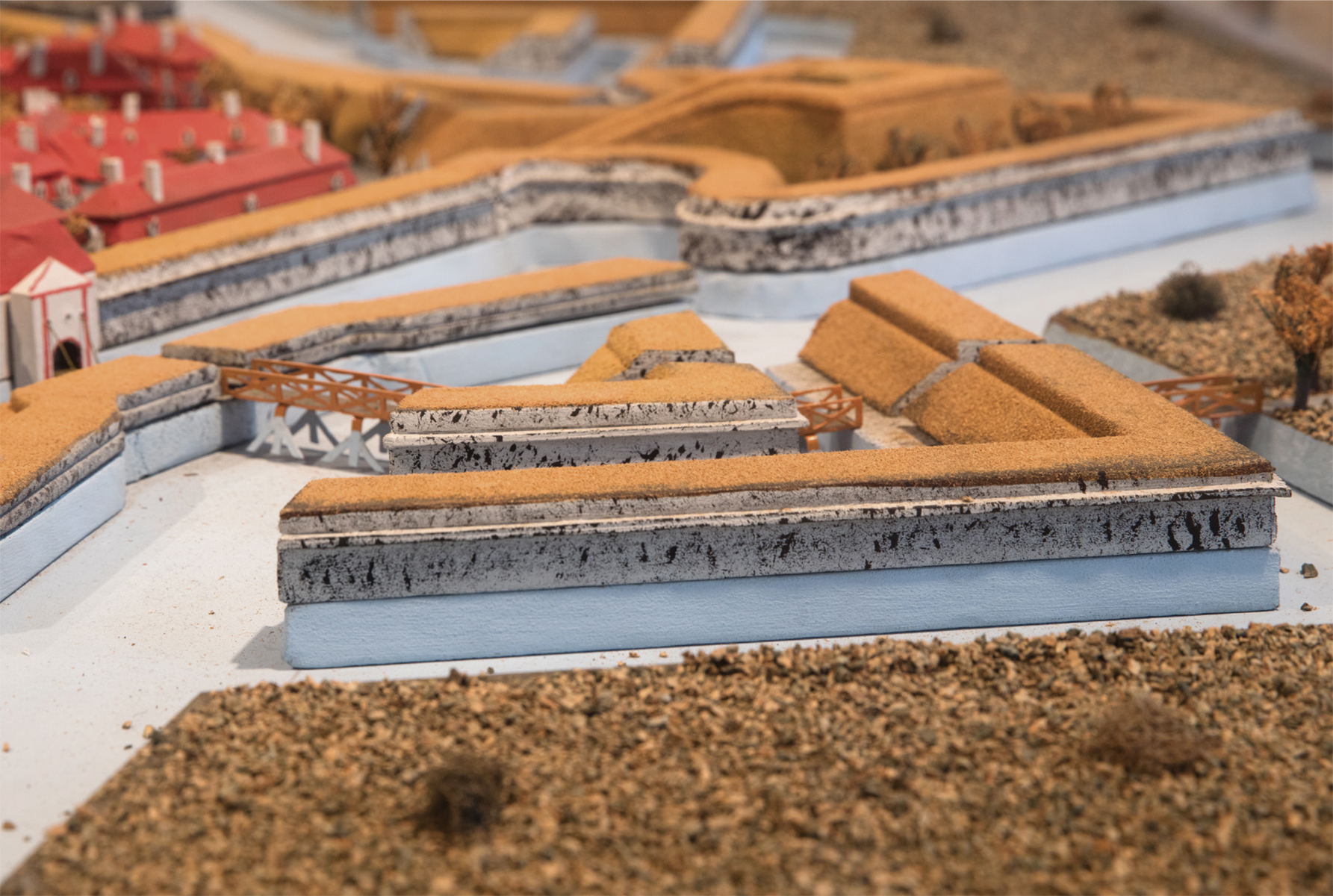
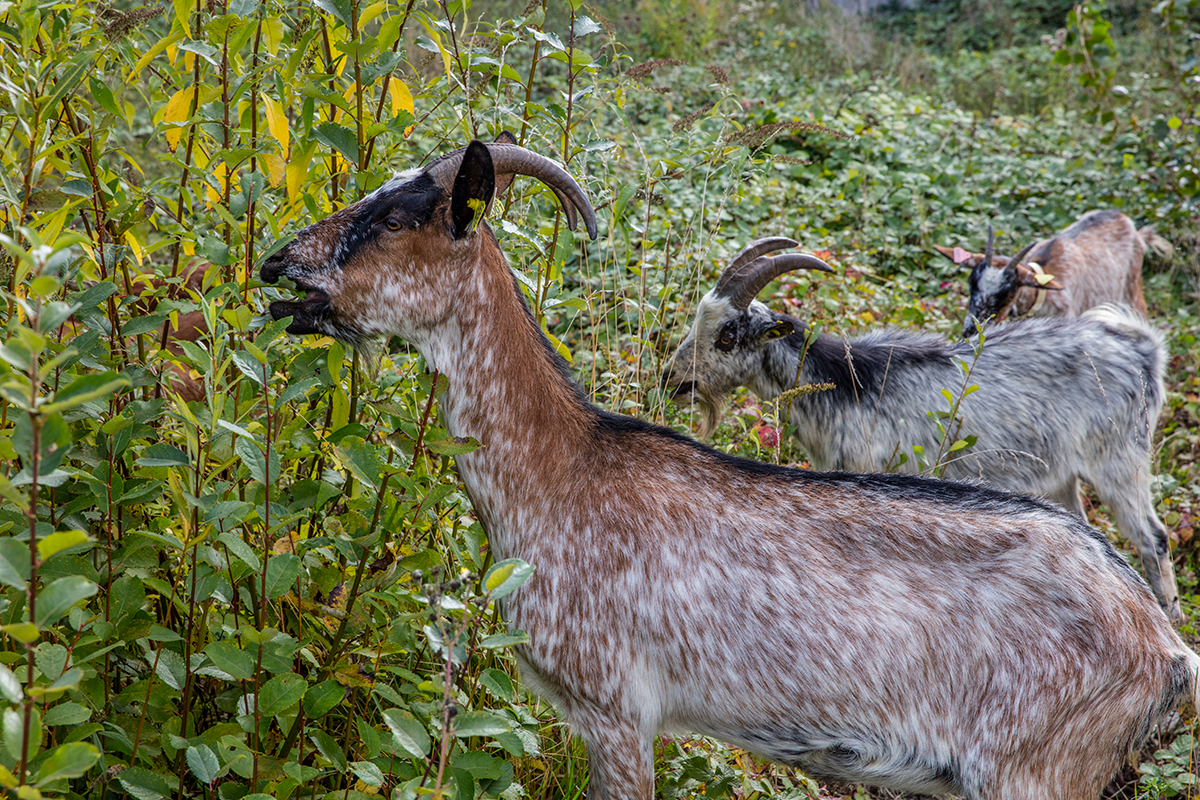
Botany
Nuances of green
Here a meadow is flowering rather than a lawn and, there wild grass grows in the gutter… this deliberate environmental approach regarding management of green areas and roadways often gives the city a little country look, which greatly benefits the biodiversity and better quality of life.
Goats and sheep
And even more so in the Jardin des Pâtures (grazing garden) where goats and sheep perfectly replace any mechanical or chemical solution when it comes to cutting the grass!
15 / Hospital garden
The Hospital garden is an ongoing project. This landscaped development will begin once the restoration of the Poudrière, another remnant of the stronghold, is fully completed. Preservation work was already carried out in 2013 and 2016.
Have an iron constitution!
Like in each border-town or fortification which I built, Huningue had a military hospital in the 19th century with 118 beds and where doctors and surgeons looked after the sick or injured soldiers. They also wanted to prevent the contagious illnesses and epidemics which were causing even more deaths than war injuries.
The operating techniques were simple and extremely quick to basically decrease the pain for lack of any real anaesthetics. The pharmacopeia was just as ludicrous: bruises from cannon-balls were treated with brandy and rubbed-on ammonia, and both brandy and wine were used against diarrhoea …
Therefore, ingenious fortifications and iron constitutions were really the best guarantee for soldiers to stay alive!
History
Underground organisation
The Huningue stronghold had about 21 undergrounds, designed to shelter 2890 men from cannon fire.
They were also used to store ammunition, grains and food. Within this incredible underground network, each gallery had a function. Some were used to deposit wine, brandy, tobacco, lard… Others were intended for cooking and keeping the bread during sieges and some others were even transformed into mills which worked using horses.
Three galleries, among the best ventilated, were used as hospitals when the wars waged.
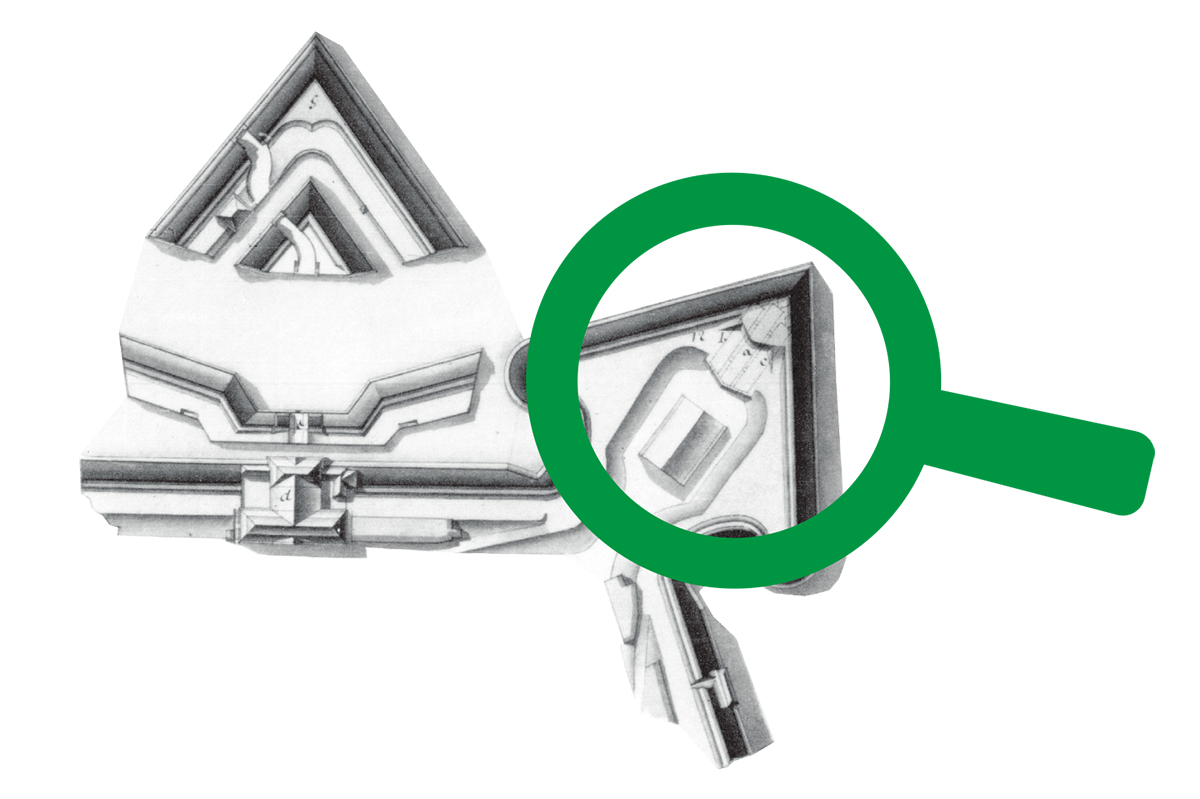
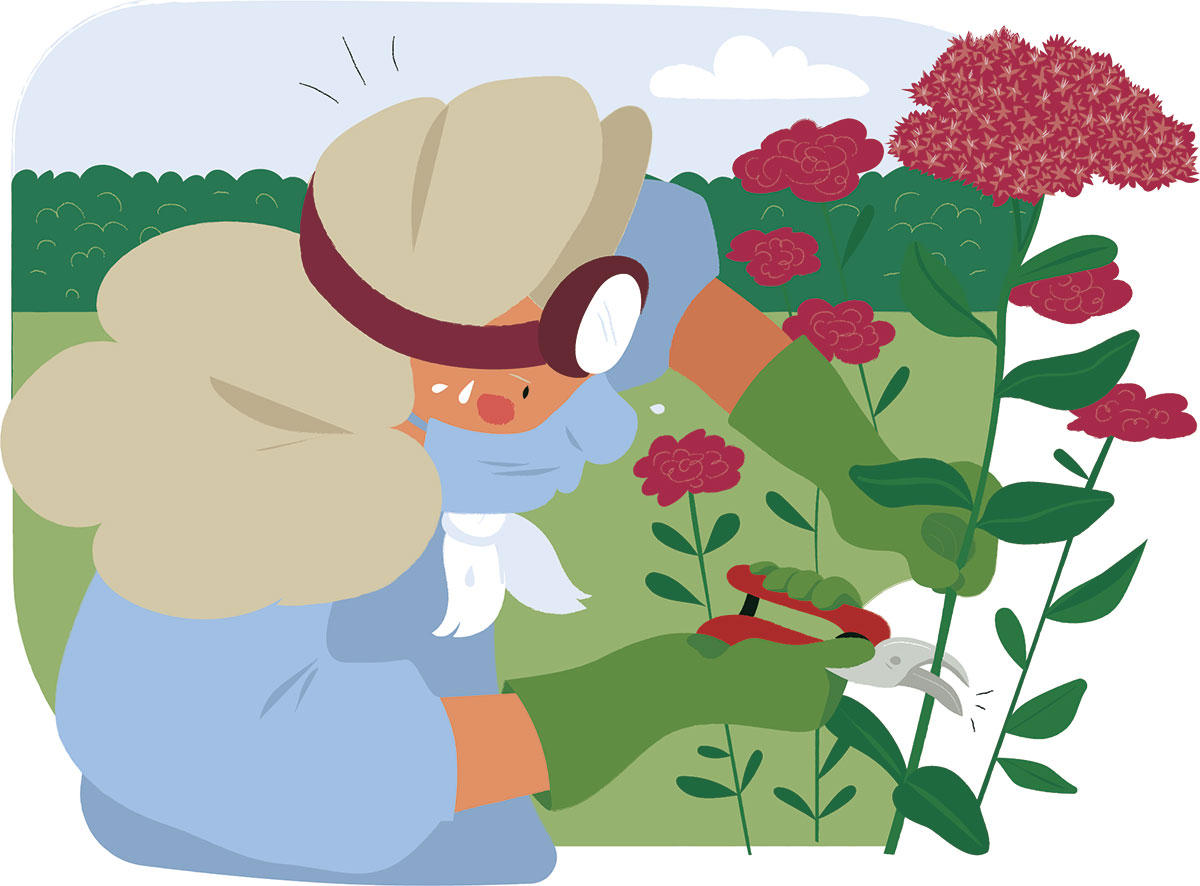
Botany
Plant medicines
The small garden behind “La Poudrière” with all its medicinal plants is a reminder that the military hospital was just a few steps away.
Its small, mysterious flower beds are preciously cared-for as the aromatic, sedative or healing plants have incredible powers. They are therapeutic when properly dosed as otherwise some of them can become dangerous poisons! Dioscorides, a disciple of Hippocrates (25 AD) already had a list of 609 plant-based “drugs”… and the Royal Garden of Medicinal Plants in Paris had around 2300 species during the 17th century!
A virtuous garden
The hospital garden modestly features mint, lemon balm, thyme and rosemary, with multiple effects when used either fresh or dry.
The beautiful Salvia officinalis sage plant also has its place, known for centuries for its stimulating properties and was even banished from the stadiums in ancient Greece. Sage is also diuretic, anticonvulsant, choleretic, antiseptic, anthelmintic… it has a worldwide reputation for boasting genuine universal remedies! Valerian, borage, common mullein and many other species are here to discover in one of the flower beds in this virtuous garden!
16 / Demi-lune Garden
The Jardin de la demi-lune is in the planning stage. It will be an opportunity to enhance the last vestiges of the stronghold.
Life in movement
From taking one enemy city to another and from border to border building dissuasive fortifications, I must have travelled nearly 180,000 km in fifty years. A busy life. Completely different from my life today in my role as official gardener of Huningue! And with no regrets as these travels educated and enriched me, allowing me to meet many people from all walks of life, and it expanded my mind in many aspects. People call me a humanist. That’s a little exaggerated. I quite simply just like people!
In a certain way, I’m still in movement despite myself within this garden which is always changing… each day I marvel at these little nothings which weren’t here yesterday and which, in certain places, incite me to leave nature alone so that it can surprise me a little more tomorrow. And so my life continues to the rhythm of a garden in movement.
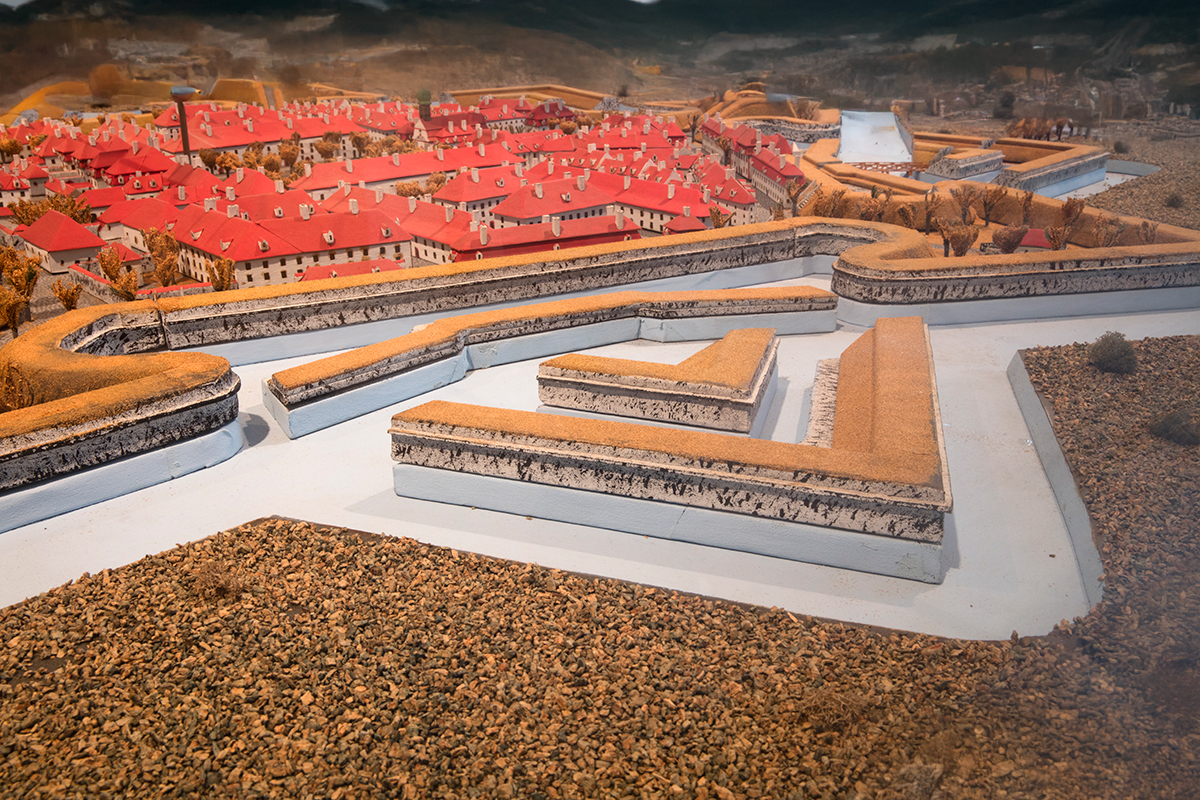
Remains of a demi-lune
In the footsteps of this demi-lune, within its partly-filled ditch, don’t think the assailants have won the battle as at the foot of the rampart under the crossfire of the stronghold defenders, their life is in the crosshairs.
History
A taker of cities or a fortifier, Vauban developed his strategies with an unfailing determination to save the lives of the King’s soldiers.
Vauban the strategist
With his participation in 48 sieges in enemy cities, Vauban designed an unstoppable attack system and learned from this experience to build (30) or repair (130) impregnable strongholds.
Vauban, taker of cities
From fine strategy to the attack, he developed zigzagged trenches avoiding enfilade fire, and combined this with concentric parallels to inexorably get close to the besieged. In well-protected places there were cannons which covered the advancing soldiers and weakened the rampart through repeated impacts.
Vauban the fortifier
Intransigent in defence, he improved the concept of buried ramparts, buffer zones and bastions making all positions defend each other, having the crossfire eliminate any blind spots where the enemy could hide. He continued multiplying his ingenious ideas to make it even harder for assailants to succeed in their missions.
Botany
A tamed wasteland
Inspired by the landscaper Gilles Clément and his Garden in Movement, the Demi-Lune Garden shook up the traditional view of a garden and the usual idea that gardeners always control everything.
Therefore, based on a wasteland model, this is a living area where the “settlers” are free to establish themselves where they want. The gardener first learns to understand all interactions between the plant or animal species and man before influencing the shadows and the light or mediating between the existing plants.
The idea is to maintain and increase biological diversity as well as the biological quality of substrates, by intervening with the least possible means. In other words, work as much as possible alongside nature and not against it. Having decided where they want to grow or live, these species are thus the kings and queens!
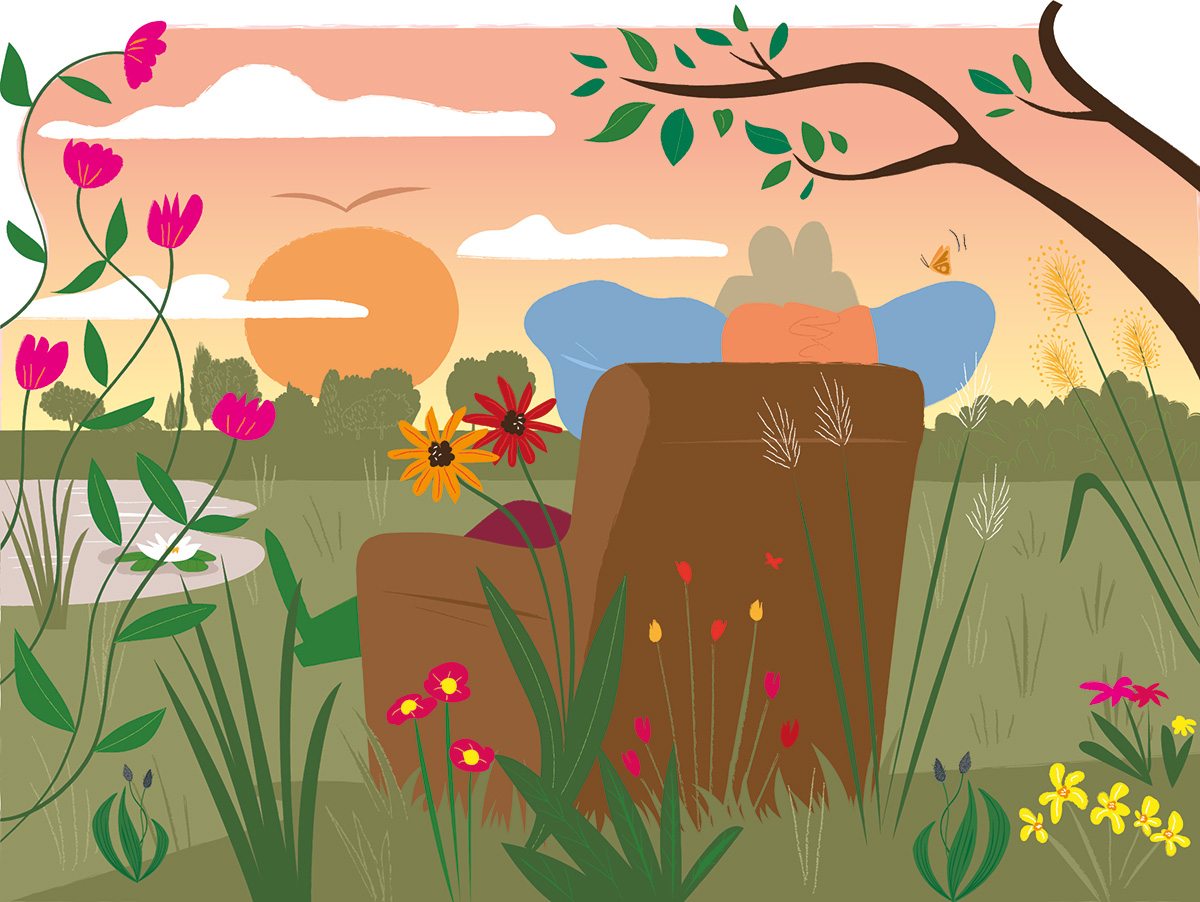
Finish
Huningue lifestyle – an example to follow!
I’ve never gone after medals or awards, which is just as well as I would have run out of breath long before being appointed Marshal of France by Louis XIV at 70 years old!
There is one though which I proudly display – my “four flowers” as it symbolises the best on the French label Villes et Villages Fleuris de France (Flowered Cities and Villages of France). A label which distinguishes more than just beautiful flowers. It also puts into perspective the promotion of our singularities, environmental respect or even maintaining social ties which are so important when embellishing the city.
But no need for a label to say that myself, Vauban, your faithful gardener, I love Huningue and its subtle art of opting for a quality life-style today and ensuring it remains this way for future generations. So yes, let’s follow the example of the Huningue lifestyle!
History
Mrs Royale makes a stop in huningue
When the negotiations for her release against about fifteen French prisoners ended, the young princess Marie-Thérèse Charlotte of France, referred to as Mrs. Royale, left Paris on December 18, 1795 during the night.
The unfortunate orphan of Louis XVI and Marie-Antoinette, and sole survivor of the royal family, spent two nights over Christmas in Huningue at the Corbeau inn (at 9, Rue Abbatucci) awaiting the last formalities allowing for the exchange to take place in Riehen near Basel. Legend has it that in Huningue, it was in fact a young lady playing out the role of the princess while the latter was living hidden away using the even more obscure identity of the “Dark Countess” of Hilburghausen.
Botany
Villes et villages fleuris
Created in 1959, the label of “Villes et Villages Fleuris de France” is awarded based on the challenges of improving the environment, development of local economy, tourist appeal, environmental respect … and most of all, for the importance plants have when planning public areas.
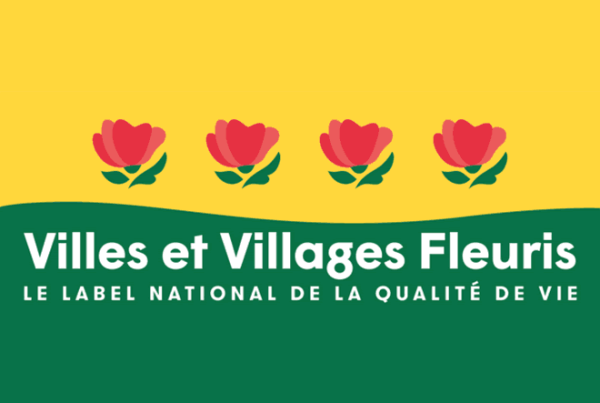
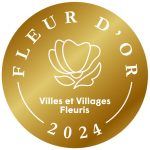
Small trade
The quality of life in a small city is also the dynamics of its merchants and services.
Let’s support them by buying locally!
